#wheres the exploration or building upon the of themes and concepts of the original game??
Explore tagged Tumblr posts
Text
they're reccing sans au posts to me now ...
#ranting#GIRL NOOOO consequences to letting myself enjoy ut posts#as i try to make it v clear i really do not want to associate w/ that community again bc ive had less than great experiences there#and theres connotations there that i would rather die than have be placed on me 💀#not to mention i kinda just . hate the concept of these sans aus now????#like dont get me wrong i do enjoy ut aus but somehow along the way it just. morphed into sans recolors#not to mention theres often like no resemblance of sans's character at all or just horribly out of character. OR just straight up both#and it just. has nothing to do w/ the og game at all its just the sans recolor#who doesnt even have any basis in his character besides being a skeleton (& even then theyre normally just skinny anime boys)#its like !!!! whats the goddamn point !!#wheres the exploration or building upon the of themes and concepts of the original game??#wheres the examination of the characters in differing situations?#like why even bother calling them ut aus theyre just something else completely#like thats what gets me. clinging onto the BARELY THERE ut relationship that's honestly undeserved#anwyay all this to say i would rather not see sans but he kills ppl or sans as neurodivergent conditions a la social media as characters
3 notes
·
View notes
Text
Navigating the Mobile Frontier: The Rise of Ionic App Development Companies in India
Raising new edges to businesses and smartphones on the count of a growing number of mobile-first world centric, never-ending exploration and discovering innovative solutions make the environment rapidly changing and highly competitive in mobile technology. As the world continues on this non-stop digital revolution, app development with Ionic has become a game changer for businesses—leading with its multi-dimensional features to provide vivid versatility, scalability, and cost-effectiveness for scaling high in the competition markets show.

In a tech-savvy India, where an innovation is infused with rising technology, Binary Informatics coupled with others like Binary Informatics is the dominant live quintessence of Ionic App Development Companies, an Improve Web Application upon other needs that are wielded to arm businesses across industries with a solution to negotiate the mobile frontier towards new growth and opportunities for success.
Ionic is actually a mobile app development framework by nature, meaning that it allows working with hybrid mobile applications programmed within the web technologies of an open-source framework. This gives one huge control of whatever it is that one will build: something that will be thick and filled with features, working on all the different platforms it's offered—be it iOS, Android, or the web. This cross-compatible nature of business means a massive advantage in reaching a layer of audience at cheaper development costs and fewer resources.
With the concept of mobility just having been conceived, at Binary Informatics, more than most people, we understand that this new phenomenon has brought in depth what issues are at hand in an ever mobile world, precisely for today's business. We unleash all the powers of Ionic so as to deliver tailormade solutions which precisely unlock exactly this with the help of skilled developers. Ground-up development or optimization of what you've got, we shall be glued at the hip to see your Ionic apps meet their intended purposes to the hilt.
That said, reduced time-to-market is only one of the many reasons why Ionic is the app development superpower. As it will help in halving the time to build due to one codebase that a developer would not have to do separately for both platforms, but one that will work with both the Android and iOS forms. With this rate of speed, the e-commerce, healthcare, and fintech industries, just to mention a few, are agile enough to give a competitive edge within the markets.
Apart from this, in Ionic, there are thousands of pre-built components, plugins, and frequently updated themes, which are already ready to be implemented, for a complete touch development and functionality. This way, this helps the developers to pool in their concentration in the development of unique features and experiences, which differentiate their app in the market. The remarkable variance in apps that is to be developed is offered in this way. At Binary Informatics, we unroll all those benefits of the Ionic framework to stand be had, to secure easy-to-use interfaces, easy navigation, and original user experiences.
It is, therefore, again another critical feature with regard to the development of mobile applications in such kind of industry that deals with sensitive data and transaction records. A box that has security already included. It further includes core building components of building libraries that give facilities such as protection against a range of common application security threats, such as cross-site scripting and SQL injection. Finally, Binary Informatics respects industry best practices to ensure our Ionic applications are reliable, secure, stable, and comply with standards, including GDPR and HIPAA.
The project management and life cycle of the apps are also great responsibilities brought to attention by Binary Informatics. Side by side, we assure extended support and maintenance for your apps in Ionic to make sure the application and code are kept updated, optimized, and secure all the time. From bug fixes and the introduction of new features to conducting a full-fledged migration operation to the newest version of Ionic, we'll be here to make sure you're constantly on your feet.
However, the rise of Ionic app development companies in India, like Binary Informatics, was not only changing the face of business for the plain augmentation but was also heading on in a new turn for the world of Indian mobiles in all. As a company, it is only possible if Indian businesses, some of the most disruptive in their class globally and driven by the latest technologies, move ahead toward the continuous Indian market in growth and competition. We enable India, untrammeled, to tap the leadership position in global offshore mobile app development work, attract investment in talent, and open opportunities from every nook and corner of the globe.
The rise of Ionic App Development Companies in India redefines the mobile frontier and opens up numerous possibilities for processing businesses across industries. An Ionic App lets your business get around the ordeal of mobile complexity and helps it reach newer, more diverse audiences to further drive forward another set of growth and innovation. In fact, having a good partnership with a leader in the Ionic app developmental core area like Binary Informatics always proves to be a handy asset in this competitive environment, when rapid technological changes redefine the way transactions are done, and one needs to stay way ahead of the curve in order to leverage the tremendous potential mobile technology has.
#hire mobile app developers in india#flutter mobile app development services india#top mobile app development in india#react native mobile app developers in india
0 notes
Text
Blog 5: Intertextuality and Transmedia - A Study of The Witcher 3: Wild Hunt

The Witcher franchise is something else. It is an adventure to some, a sorrowful experience with love and hate to others, and somewhere in between to the rest. To me, it is an adventure of epic proportions.
So, is The Witcher 3: Wild Hunt a form of Intertextual media? I believe it to be so, yes. Let me explain why.
The Witcher franchise stands as a unique and multifaceted experience, offering different perspectives to its diverse audience. For some, it is an epic adventure, while for others, it unfolds as a poignant journey entwined with themes of love and hatred. To me, it represents an adventure of monumental proportions. Now, let's explore whether The Witcher 3: Wild Hunt can be considered a form of intertextual media. I contend that it indeed falls under this category. The Witcher franchise, primarily a video game series, is inherently intertextual, drawing inspiration, references, and influences from various sources. Originating from a series of books by Polish author Andrzej Sapkowski, the games intricately build upon the narrative and character development laid out in the literary source material. Widely recognized for its deep ties to Polish folklore and mythologies, the franchise's richness is attributed to Sapkowski's Polish background and his foundation of the narrative in a fantastical version of Poland, where monsters and magic coexist.
Is The Witcher 3: Wilt Hunt a form of transmedia? Not per say. Let's figure out why.
I believe it is important to differentiate between the game itself and the broader franchise. While the game contributes significantly to the overall transmedia narrative, it may not be considered a standalone transmedia piece. Transmedia storytelling involves crafting a unique narrative across multiple platforms, each contributing distinct content and perspectives. The Witcher franchise, on the other hand, emerges as a transmedia entity, where the narrative threads woven between the games collectively contribute to the greater narrative and world-building of The Witcher universe. Examining the narrative structures within The Witcher games introduces the concepts of structuralism and poststructuralism. While some may debate whether the games strictly adhere to either framework, it is crucial to recognize that video games, as a rapidly evolving medium, pose unique challenges to traditional narrative methods.
The Witcher games can be seen to navigate this complexity by combining elements from both structuralism and poststructuralism, refusing to align strictly with either framework. Instead, the games draw from a variety of narrative traditions, including character-driven storytelling, world-building, and moral ambiguity. In essence, The Witcher games defy easy categorization within the confines of structuralism or poststructuralism. The narrative intricacies reflect the dynamic nature of video games as a medium, showcasing the flexibility to incorporate diverse storytelling elements. The Witcher franchise, in its entirety, emerges as a captivating blend of intertextuality and transmedia storytelling, inviting audiences into a rich and immersive world shaped by literary influences, cultural connections, and the evolving landscape of video game narratives.
To quickly summarise the part about narrative structures, the Witcher Games combines elements from both structuralism and poststructuralism in its narrative department. The game, nor any game for that matter, fits neatly into either of the two categories.
Sources: Allen, G. (2011). Intertextuality. Routledge. doi:https://doi.org/10.4324/9780203829455. [Accessed 21 Oct. 2023].
Anon, (n.d.). What is intertextuality in media? – TipsFolder.com. [online] Available at: https://tipsfolder.com/intertextuality-media-f45863ffd31b7de4ca73ca26e68d94fa/ [Accessed 21 Oct. 2023].
Anon, (2022). What is Transmedia | Definition, Meaning and Examples. [online] Available at: https://www.arimetrics.com/en/digital-glossary/transmedia.
Audible Blog. (2021). The Witcher Characters, Explained: A Family Tree & More. [online] Available at: https://www.audible.com/blog/article-the-witcher-characters-explained [Accessed 21 Oct. 2023].
Barron, K. (2021). What Is Intertextuality? Definition and Examples. [online] TCK Publishing. Available at: https://www.tckpublishing.com/intertextuality/.
BBC Bitesize. (2021). What is genre? - GCSE Media Studies Revision - BBC Bitesize. [online] Available at: https://www.bbc.co.uk/bitesize/guides/z98n4j6/revision/2.
BOURDIEU, P. and Zanotti-Karp, A. (1968). STRUCTURALISM AND THEORY OF SOCIOLOGICAL KNOWLEDGE. Social Research, [online] 35(4), pp.681–706. Available at: https://www.jstor.org/stable/40969937.
Christophe, D. and Christian-Marie, P. (2016). Contemporary Research on Intertextuality in Video Games. [online] Google Books. IGI Global. Available at: https://www.google.co.uk/books/edition/Contemporary_Research_on_Intertextuality/juR5DAAAQBAJ?hl=en&gbpv=1&dq=intertextuality+in+games&pg=PR1&printsec=frontcover [Accessed 23 Dec. 2023].
SamynBloggerFebruary 16, M. and 2011 (2011). Video Games as Media. [online] Game Developer. Available at: https://www.gamedeveloper.com/design/video-games-as-media.
Stone, C. (2019). The evolution of video games as a storytelling medium, and the role of. [online] Game Developer. Available at: https://www.gamedeveloper.com/design/the-evolution-of-video-games-as-a-storytelling-medium-and-the-role-of-narrative-in-modern-games.
This vs. That. (n.d.). Poststructuralism vs. Structuralism - What’s the Difference? [online] Available at: https://thisvsthat.io/poststructuralism-vs-structuralism [Accessed 21 Oct. 2023].
Techopedia.com. (2019). What is Transmedia? - Definition from Techopedia. [online] Available at: https://www.techopedia.com/definition/30425/transmedia.
Time. (2019). ‘The Witcher’ Borrows Heavily From European Folklore. Here Are the Myths That Inspired the Netflix Show’s Monsters. [online] Available at: https://time.com/5753369/the-witcher-history-folklore/.
0 notes
Text
Getter Robo Retospective - Getter Robo Part 1 -Ryoma Nagare
So, Iv’e been wanting to do an overall retrospective of the Getter Robo manga franchise for a while now, and since the Getter Robo Arc is nearing it’s finale as of the time of this writing, and will either give it a definite ending, or be the final nail in the coffin that the series will never be finished before Getter Robo falls into public domain, I thought now might as well be the time to do it.
As such, I’ll be doing an overall analysis over the entire collection of Ken Ishikawa’s Getter Robo manga series, it’s plots, themes, characters, and covers the various ideas this crazy and amazing sci-fi series covers.
Also, this retrospective will NOT cover the various anime adaptations, or the behind the scenes stuff that has gone on with Getter Robo over the years, such as Go Nagai being credited as the writer of the original manga despite only having come up with the overall concept and designs for it(the rest was by Ken Ishikawa), or the way that Ken went back and added in some extra chapters in the original two manga to explain some things and to tie the early manga more closely into what came after.
For the purposes of this retorspective, I will be focusing exclusively on the manga itself, and what it has to offer, without going into anything else.
And of course there is no place better to start, than the beginning.
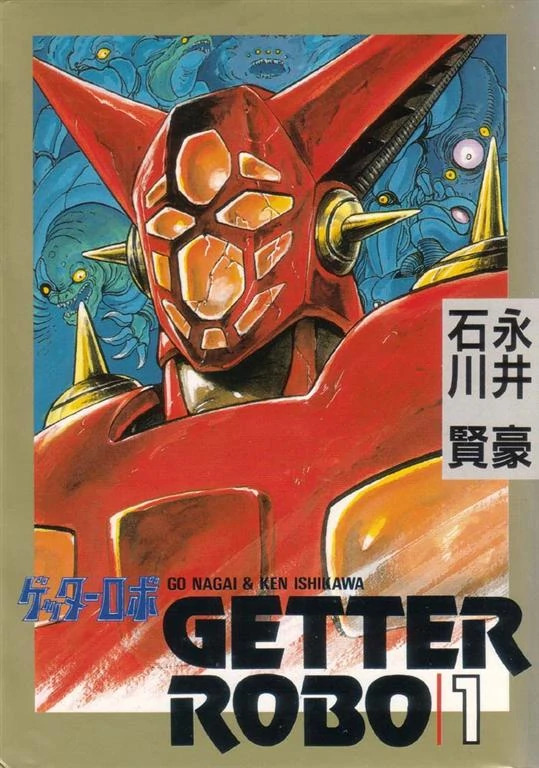
So, what is the story of the original Getter Robo Manga?
Well, the overall plot of the original manga is about the conflict between two sides of a conflict, as laid out rather well in it’s prologue chapter.
The first is our protagonists, the Saotome Institute of Japan, who’s leader and namesake has invented the titular giant mecha, the Getter Robo.

Powered by a revolutionary newly discovered form of energy called “Getter Energy”, this enormous metal behemoth is a fighting machine unlike any other.
This war machine was originally supposed to be used for space exploration, but due to necessity, it has instead been reworked into a fighting machine.
It’s only weakness is that it requires 3 different living pilots to operate it to draw upon its full strength.
Opposing the Saotome Institute, is the forces of the Dinosaur Empire
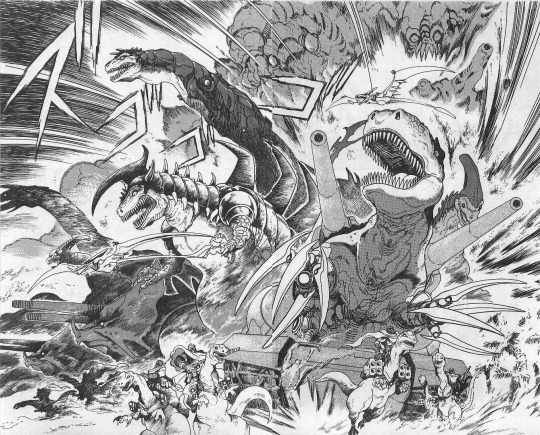
An empire of humanoid Sentient Dinosaurs that long ago was forced to flee the Earth’s surface after it was bombarded with a strange kind of energy from space that was deadly to their kind, their only way to survive being to use their incredible technology to hide on the only place on Earth where the rays couldn’t reach them. The Earth’s very core.
Now, after millions of years underground, and the rays that forced them beneath the earth to begin with having seemingly ceased, they have finally returned to reclaim the earth’s surface for their own. At it’s disposal, it has incredible technology, and giant cyborg dinosaur monster in it’s quest to wipe out the newcomers, the human race, to achieve total dominance over the Earth.
If you think this premise sounds very generic, and you’ve seen it in some form or another in countless other Mecha series, you are not wrong. Ancient evil group attacking the protagonists, and only the new giant robot can stop it, probably the biggest stock plot in mecha overall, having been done in everything from Neon Genesis Evangelion to Megas XLR in some form or another. The set pieces and details are different, but the overall plot is the same.
However, where Getter Robo fits into this, is that it was one of the first giant robot manga there was, and many, many of the tropes and ideas it pioneered would be used and imitated by its successors.
In fact, I would argue that Getter is the second most influential mecha series in history, only second after it’s big cousin, Mazinger Z.
However, we are not here to detail how it influenced the manga industry, but how Getter holds up on it’s own, and in this regard, despite having a plot that has been overused time, and time again by it’s successors, this isn’t really that much of a problem for Getter Robo. Because like any good Mecha series, Getter’s biggest strength is it’s cast of characters.
Starting off in chapter 1, we are introduced to the first of the Robot’s giant pilots.
Ryoma Nagare.
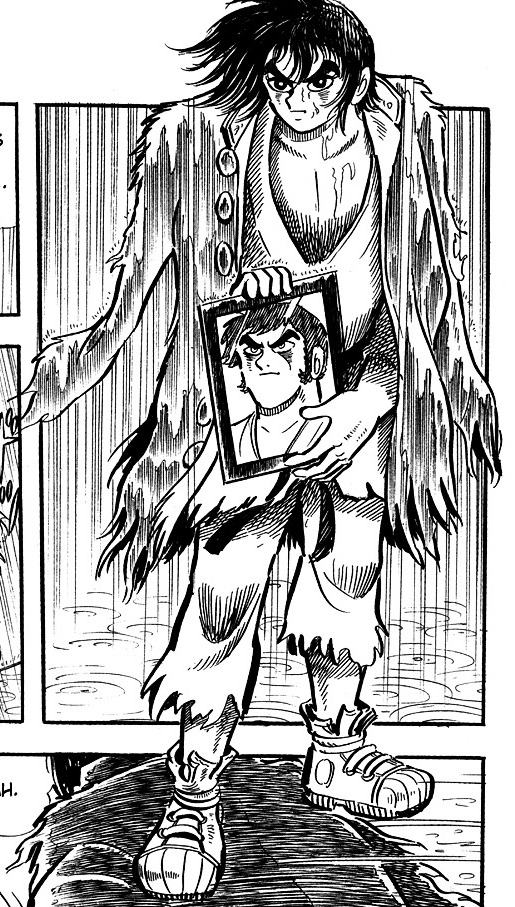
Each of the pilots of Getter Robo is given an introductory mini-arc to set them up, and Ryoma’s is easily the best of the 3.
We are introduced to the main character of most of the franchise at a very unusual spot to open a main character, especially for a Shonen protagonist.
At the end of a revenge story.
To put it bluntly, Ryoma does not start off this series as a particularly likeable, nor good person, as his introductory scene is him crashing a perfectly legal martial arts tournament and beating the everloving shit out of it’s referee, it’s participants, and the judges who arranged it.
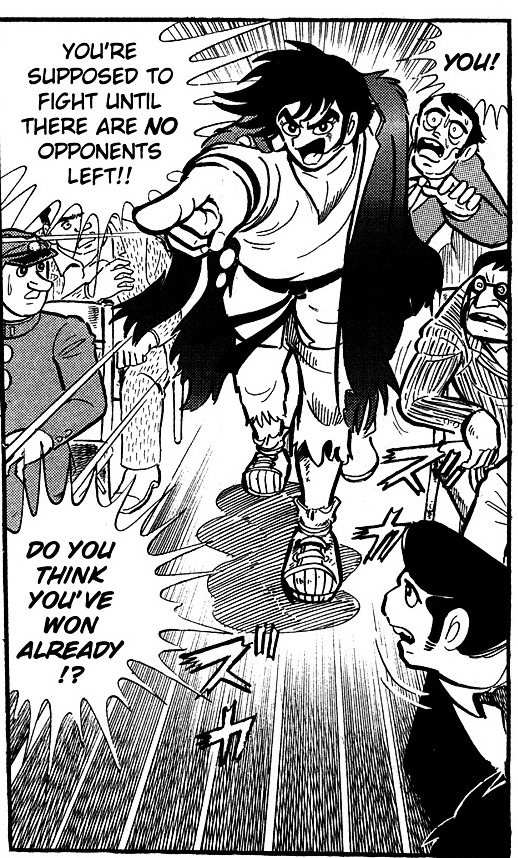

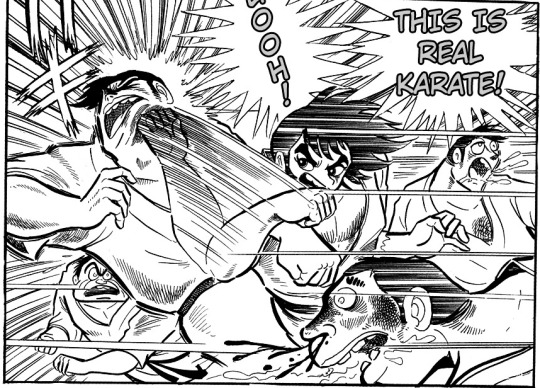
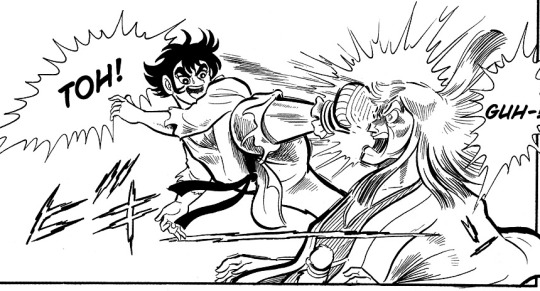
His reasons for doing all of this?

Revenge for his old man.
As it turns out, Ryoma had a massive beef with the arrangers for this contest, as his father, Ichigan Nagare was a pro karate champion back in the day, whose reputation was purposely destroyed by those arrangers.
Now he’s come to take revenge by utterly crushing their disciples on national television, to hammer in the point that his father’s martial arts was superior to theirs for all the world to see.
During this whole thing, we also get a very good look into how Ryoma thinks at this point in time.

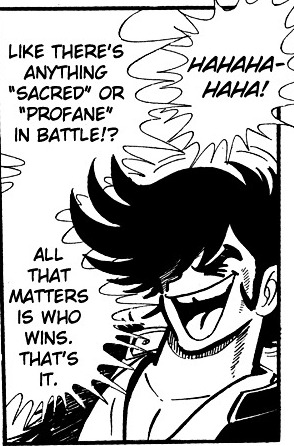
When the arranger tries to appeal to the “Sacredness” of the Sport to get him to stand down, Ryoma laughs in his face, proclaiming that there is nothing sacred about combat at all. The only thing that matters is who emerges as the victor.
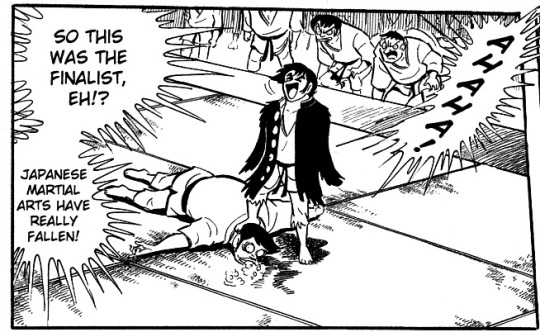
This is backed up by how he doesn’t show the least bit of compassion or honor to the first of the contestants he defeats, easily smashing him to the ground then gloating over him after having demonstrated the sheer difference in the combat prowess between the two of them.
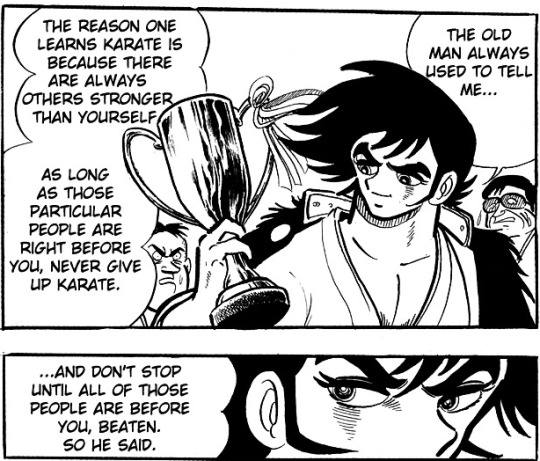
He is very blunt about the fact that he believes that one should pursue strength for strenght’s sake alone, and never stop until you have crushed anyone who stands before you. Always train to get stronger, and always seek out those who can challenge you and beat them too.
Might makes right.
This is a REALLY good introduction for showcasing Ryoma as a character. How he thinks, his immense near superhuman strength, his ruthlessness, his pride in his own strength.
It also ties in directly into the themes of this series, as this kind of thinking is essentially Evolution itself boiled down to it’s bare core. The survival of the strongest. What is the point of Evolution after all, if not this? Those with the traits to survive and thrive will do so, while those who cannot, will be crushed by those who can, who in turn will pass down what made them successful to begin with.
Of course that is not what the actual message of this series is, but it is a concept that this series is rather blunt about, and it’s not a coincidence that the most prominent of all the main characters of this series began his journey while believing wholeheartedly into that ideal.
All in all this scene is just great, and it sets up Ryoma really well, as well as making it clear that this is a boy who has a lot of growing to do as a person.

And so, having achieved his life’s work that he’s trained for for years and years, Ryoma nagare quietly leaves the arena, leaving behind a dozen bruised, battered and broken men on the ground.

Of course this display of power has not gone unnoticed, as in the audience were two men from the Saotome Institute who came here hoping to find someone strong enough to pilot their giant robot.
As it happened, they just found one that fit the bill rather spectacularly.
Then in the next scene we are showcased Ryoma’s home.
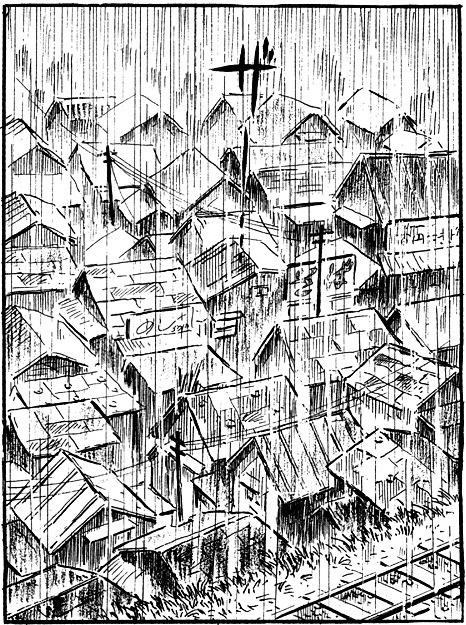
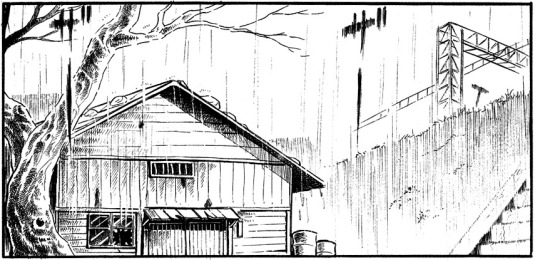
Ryoma Nagare, a fighting genius that at the tender age of 16-17 smashed the greatest karate practitioners in Japan with ease while being outnumbered a dozen to one, lives in a ramshackle part of town, in a rundown old building that has broken windows, a leaking roof, and can at best be called a ramshackle cottage.
It’s a rather brutal contrast to the sight of the prestigious, well made and maintained karate tournament building we were just in.

Inside we find the sight of something else rather unusual for a Shonen protagonist. Having now achieved his goals, and avenged his father’s memory, Ryoma is slowly starting to come to the realization that this has all been one giant waste of time. He hasn’t actually earned anything on this journey. His father is dead, he’s still poor, and his only belongings is this shitty building and the clothes on his back.

As we learn here, Ryoma has spent his entire life being trained in martial arts, to insane degrees even for an adult man, much less for a child. All for the purpose of one day doing what he did today, and avenging his father’s memory.
This scene really hammers in the fact that for all his ridiculous strength, Ryoma is a child, and he has a child’s way of looking at things.
He thinks back fondly on being pitted against stray dogs in death matches, and he reveals here that in his mind, this was all about “Redeeming” martial arts somehow, as if this display would really change anything in the grand scheme of things within the sport.
It wasn’t of course. This was all about revenge. Everything Ryoma ever trained for was for this moment, this moment of what should have been absolute and total triumph as he achieved a truly spectacular victory and proved his father’s fighting style the best in all the land and he has proven that he himself is the strongest fighter in all Japan.
Instead he is coming to the realization that so many people that wasted their lives on vengeance have come to over the years. That it was all a giant waste of time.
Revenge is a suckers game.

Having achieved his goals, Ryoma has found them to be completely empty, and has nowhere to go. This is a really fascinating way to open up a character arc, as usually a character that learns the lesson that David Xanatos knew so well, happens either at the end, or somewhere later down their line. Ryoma however, learns it in the very first chapter, and now has to find something else to live for.
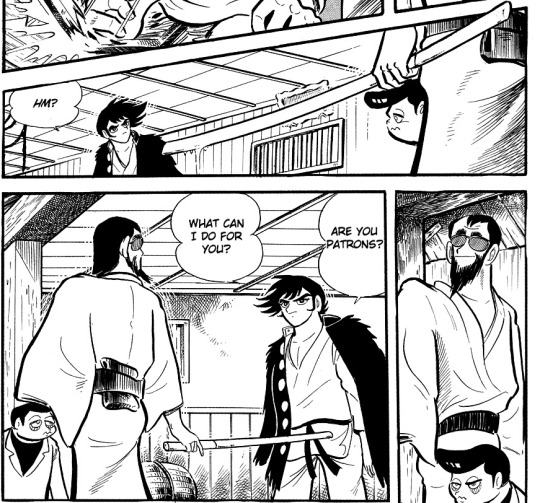
However, his soul searching is then interrupted by a few gentlemen from the Saotome institute.
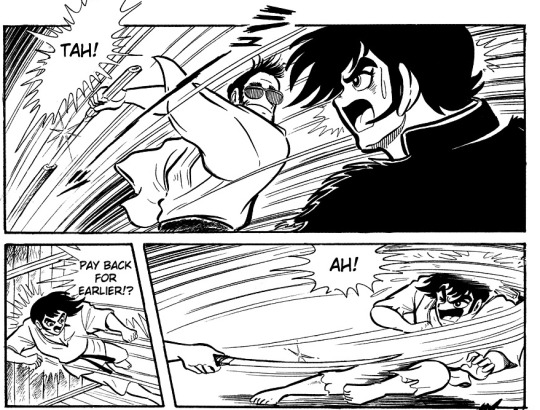
Who immediately tries to kill him.
Now before I discuss the next part, I wanna praise this overall scene, because it really works great within the context of this chapter.
Ryoma has been introduced as a massive asshole, who firmly believes in the mantra of Might makes right, and he doesn’t feel any regret at having brutalized a dozen of innocent people, just the fact that he realizes that there was no real satisfaction to be had from it. Now the other shoe drops, and HE is attacked in his own home, completely unprovoked for reasons that frankly he has no personal involvement in on his own side. While this attack does have an in universe reason behind it, it main purpose is that it serves as a nice cathartic moment for the reader, as while he’s never going to legally punished for what just happened at the tournament, he is punished by the narrative for his actions, which is something i’ve seen far, far too many stories do over the years fail to do with asshole protagonists.
It also serves to put Ryoma’s current belief in Might Makes Right to the test. After all, aren’t these men doing exactly what he said that those who practice martial arts should do? Seek out those stronger than them, then crush them.
All of this makes it a shame that it is horribly undercut by the one, genuine stain on the original manga. Namely that one of the attackers is this guy.
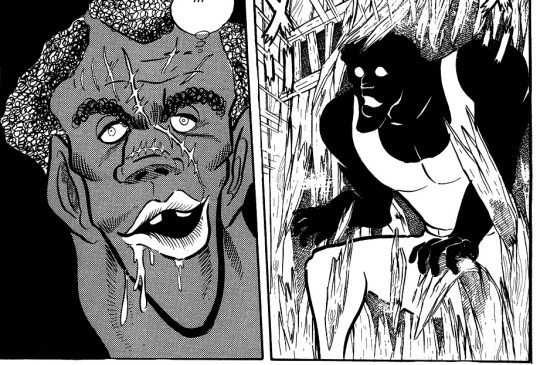
And it’s at this moment you realise, oh yeah, this was made in 1970’s Japan. The unfortunate fact is that Mangaka of this period generally based their depiction of black people on early American comics(Which had plenty of this kind of artwork), and Ken Ishikawa was unfortunately not an exception to this rule.
He would THANKFULLY not repeat anything like this later down the line(his depiction of black people is far more natural and realistic in later manga), but hot damn is it both uncomfortable and distracting to read the pages with this guy. And it’s a real shame too, because frankly, not only is the following fight scene very good as a narrative punishment for Ryoma, but it’s just a good fight scene in general.
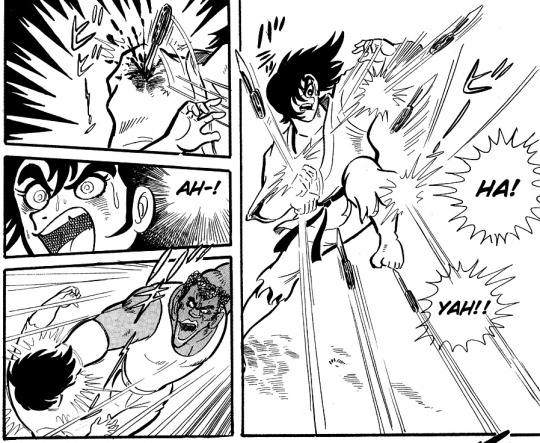
Unlike the Tournament fight, which was mainly a beatdown to establish Ryoma’s ridiculous strength, this is an actual fight, which showcases Ishikawa’s ability to draw energetic, exciting fight scenes where action flows very naturally.
It also shows that for the kind of ridiculous strength Ryoma possess, he isn’t some superhuman, as early in the brawls he’s heavily wounded by the rather mundanity of taking a throwing knife to the shoulder. This is in general something that makes action if Getter Robo stand out from other shonen series too. When characters, or Robots for that matter, takes hits, they rarely shrug them off with no problem, instead taking real, genuine damage that doesn't just instantly go away. They might power through them, but that isn’t the same as them disappearing into the ether.

In any case, the battle ends up outside the house when Ryoma is thrown through the wall.
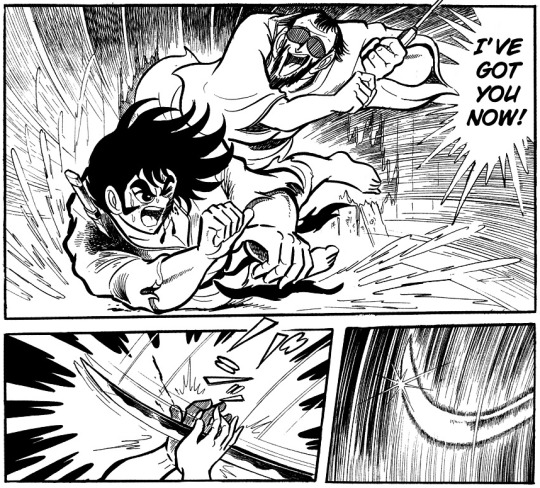
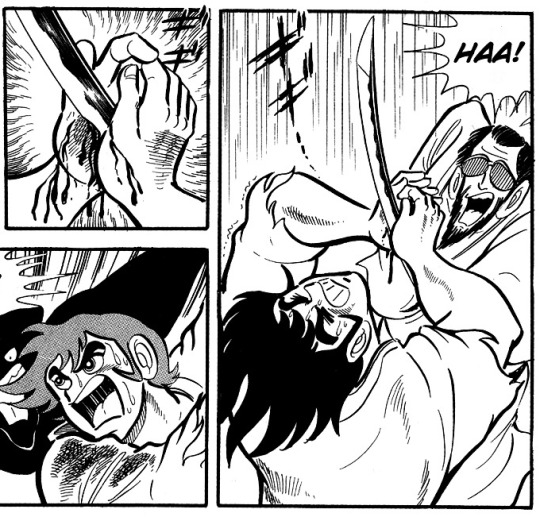
He’s then forced to do the classic, catch the blade between the palms of his hands trope, which is depicted much more believable than most cases I’ve seen, as despite succeeding, it still left him bleeding from those palms.
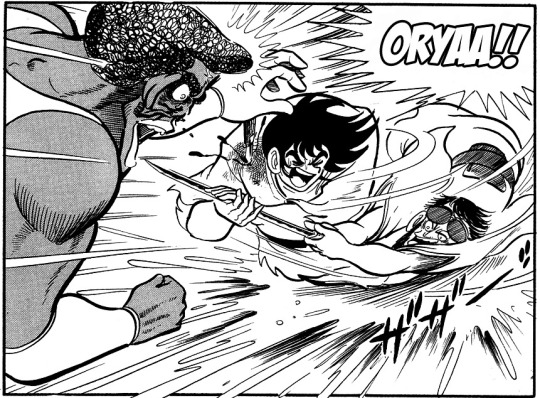
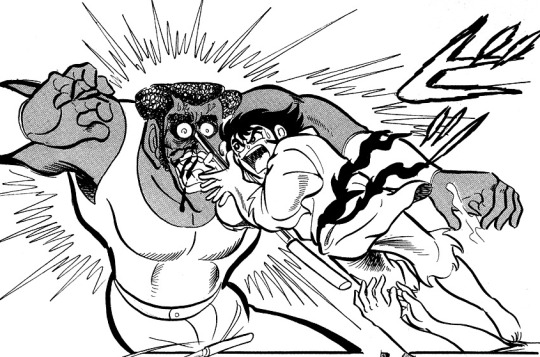
Ryoma then redirects the blade into the big guy who is attacking him from behind, killing him. I really love how the artwork sells that this is a desperate move on Ryoma’s part. He is genuinely fighting for his life here, and he’s pulling out every trick he has to to win despite his wounds.

He then follows that up by ripping the blade out, and throwing it at the knife thrower guy. I also like that after doing so, he immediately falls flat on his ass, in a rather realistic manner(he is fighting in the rain after all, so the ground is undoubtedly pretty slippery.), while also showcasing the force of the throw. My only main complaint is that for this one panel Ken forgot to include the wound and the knife on his shoulder, as I think it would really sell just how desperate Ryoma is here if we’re visually reminded in the moment that, oh yeah, he’s powering through and using the arm whose shoulder has a knife in it to to throw this thing.
Thankfully, that missed opportunity for visual grittiness is more than made up for by the next part.
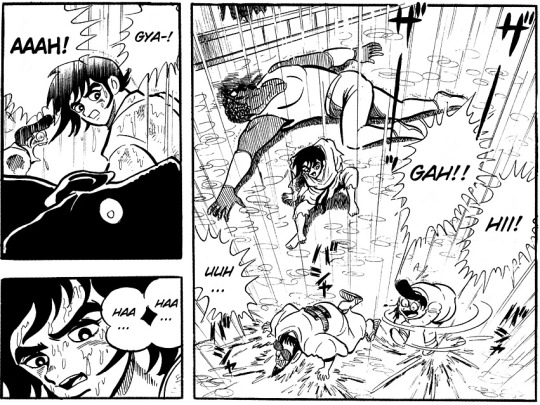
Having now effectively won the battle(I think the swordsman broke his foot in the fall, at least that’s how it looks), Ryoma suddenly realises that, holy shit, he just killed someone. The contrast between here and how he looked as he challenged the tournament fighters couldn’t be more different. The cooky, arrogant youth is completely gone, and you're reminded that Ryoma is just a kid. A kid who just had to kill someone. The bravado is completely gone, leaving only a kid who is tired, confused, in pain, and probably pretty scared.
He is then approached by the man who just had 3 grown ass men jump and attack him, Dr. Saotome.
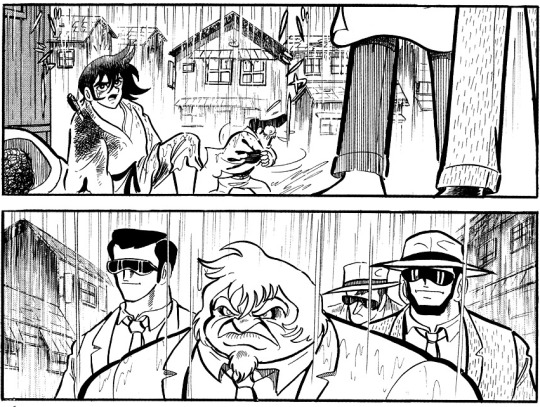
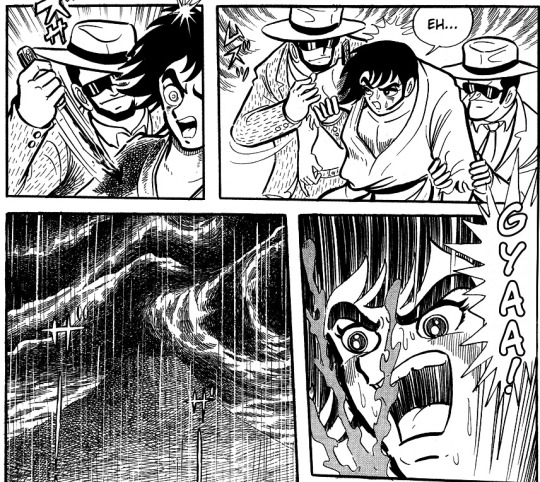
Wounded, and mentally exchausted as he is, he is in no position to argue as Saotome declares that Ryoma is what he’s been looking for, and as one of his men rips the knife out of his shoulder, Ryoma screams before losing consciousness from the pain. Afterwards he is dragged into a car, and bandaged up.
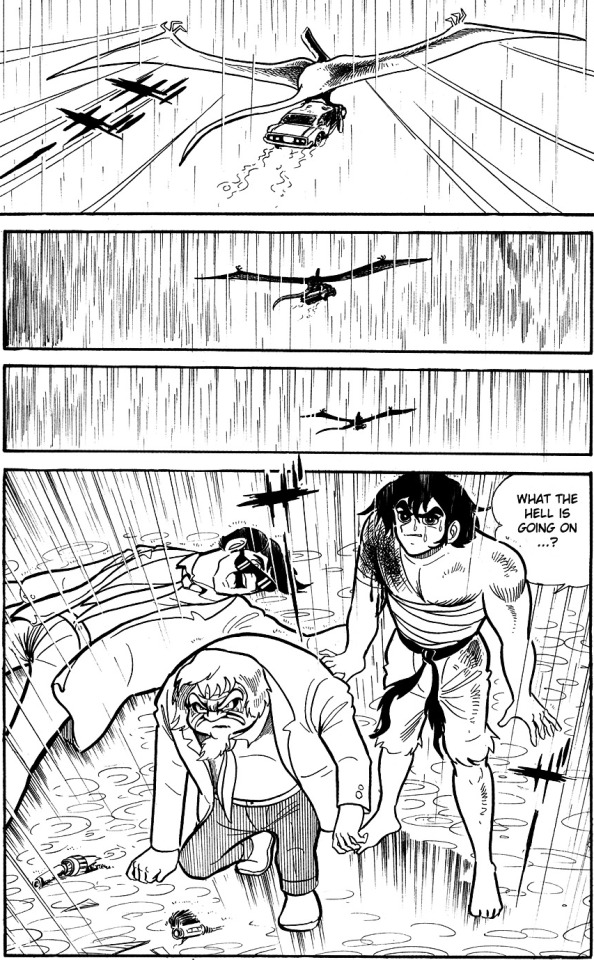
Then as they're driving, the’re attacked by a giant flying dinosaur that grabs unto the car and flies away with it, Ryoma and Saotome barely managing to get out in time, alongside one of Saotome’s unlucky goons who breaks his neck in the fall.
And so ends Chapter one of Getter Robo.
All in all, other than the horribly racist black guy, this is a really good first chapter, that sets up Ryoma Nagare really, really well, showcasing his way of thinking, his origin, and where he needs to grow, while also showcasing his ludicrous strength, and that he is fully capable of going balls to the wall to win a fight, which will be showcased many, many times in this series. It also ends on a reminder of the fact that oh yeah, this is a series about one side vs dinosaurs, as Ryoma gets his first introduction into the enemy he will be fighting time, and again in this manga. It also gives a distinct first impression of just how ruthless Saotome is, as he is perfectly willing to send 3 dangerous goons on a teenager just to test his prowess in battle, which is absolutely going to come into play in future chapters.
All in all, it’s a good start. Not an amazing beginning, but certainly a good introduction to our first main character.
40 notes
·
View notes
Text
Kicking Acts and Taking Names
Review: Actraiser Renaissance
It's hard to improve upon greatness. Admittedly, the name ActRaiser might not mean a lot to modern gaming audiences, but when it was originally released 30 years ago for the Super NES, it was widely lauded for its unique combination of side-scrolling platforming action and top-down world-building simulation, held together by a captivating world-reviving premise and one of the most impressive, technology-defying soundtracks ever created. Rarely imitated and never duplicated, ActRaiser gained a cult following and for years was revered for its innovation, accessibility, and rewarding gameplay.
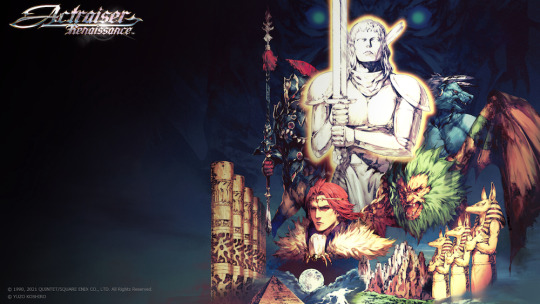
As such, the dev team behind Actraiser Renaissance - a from-the-ground-up remake of ActRaiser - doubtlessly faced an unenviable challenge: making the game relevant to contemporary players while still retaining the elements that made the original such a standout. And make no mistake: Actraiser Renaissance is a remake in the truest sense. Though the game uses the same concepts and components as the original, they are thoroughly rebuilt, remixed, and reassembled in news ways. The core gameplay and structure remain, as do the general maps, level themes, set pieces, enemies, and even the dizzying drop from the heavens - but very little is the same as it once was. Some levels are greatly inspired by the architecture and design ideas of the original, while others expand upon upon their 16-bit predecessors in a number of ways. In other regards, Renaissance feels like a whole new game - despite looking familiar, for example, bosses use completely different tactics and require entirely new reprisals.
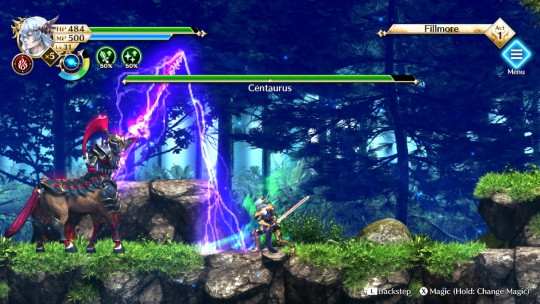
What's important, though, is that the sword-swinging fantasy action is still satisfying and fun. It's simple enough to jump into an action stage and start slicing away at enemy beasts, now with combat options that have grown considerably since the original game. Movement is more fluid and responsive, and your repertoire now includes a rising sword strike and diving slash, along with an evasive dodge that's essential for survival in the Normal and Hard difficulty settings. Enemies also now drop crystals that increase your power and boost your chances of survival, plus you can now switch magic abilities during action stages instead of being stuck with whatever one you've chosen beforehand. The reimagined levels are diverse and well designed, with multiple routes and permanent stat boosts hidden off the beaten path to encourage exploration and replayability.
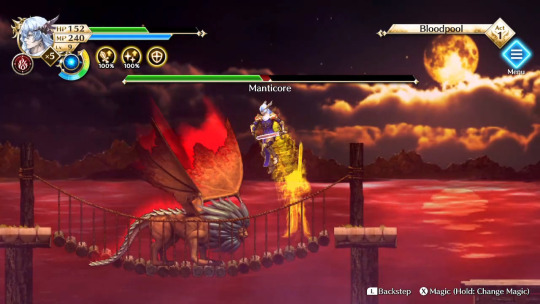
While the action stages don't stray too far from the original 16-bit concepts, the simulation segments have expanded considerably - most notably with the inclusion of new tower defense/real-time strategy segments. In the vintage game, the simulation segments were light and breezy affairs; you'd guide the direction of village construction, shoot enemies as an angel, solve a few problems with elemental miracles, and have a new civilization ready to go in 30 minutes or so. Not the case in Renaissance - you can expect each region's simulation scene to take a couple of hours, much of which is spent placing and upgrading three types of defensive constructs to protect against enemy hordes that attack at mostly predetermined points in the civilization's growth.
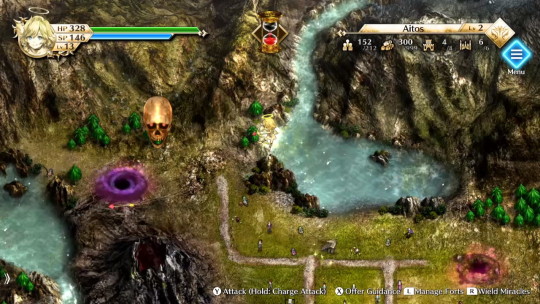
Unfortunately, these RTS sections feel half-baked; critically, you don't know where the enemies will be coming from in advance, and you can't move your emplacements during enemy assaults, so it comes down to luck or playing, failing, then retrying after repositioning your defenses - but even then, it can be hard to determine enemies weaknesses (which dilutes the strategy), and there are often arbitrary placement restrictions that make these segments needlessly convoluted.
More successfully, the simulation scenes also introduce new hero characters. They can be guided much more directly and are essential for stopping the enemy onslaught, but perhaps more importantly, they are integral to the game's more fleshed-out story and inject an appreciated dose of humanity that was absent in the original ActRaiser. Though these heroes are initially specific to each region, they can eventually be summoned to participate in other areas' RTS battles should the need arise (and it will). And it isn't just these new heroes that add to the game's personality. Tanzra's minions - the enemy bosses - have become full-fledged characters as well.

The game has changed in numerous other areas too. New, brief action stages occur when you seal monster lairs, adding variety to the now-lengthy simulation segments. And diehard fans will notice countless minor adjustments to the story beats and play mechanics, with some aspects more transparent and others more obtuse: for example, your performance in action stages no longer dictates the maximum size of your community, experience is now gained by completing quests rather than simply based on total population, and accomplishing certain tasks tends to reward you with EXP boosts for the hero characters rather than key items like in the original game. (In fact, the opportunity to use and share "offerings" is overall quite diminished.) But the best change, without a doubt, is an entirely new area at the end of the game after the credits roll, which includes both a new action stage and simulation map, and comes complete with a new boss.
Aesthetically, Actraiser Renaissance is pleasing to look at. The action-stage visuals are solid if not especially spectacular, but the game truly shines during the simulation scenes, which now boast a level of detail never previously imagined. The overhead maps now actually resemble living, breathing, thriving communities rather than the comparatively primitive approximations from the original.
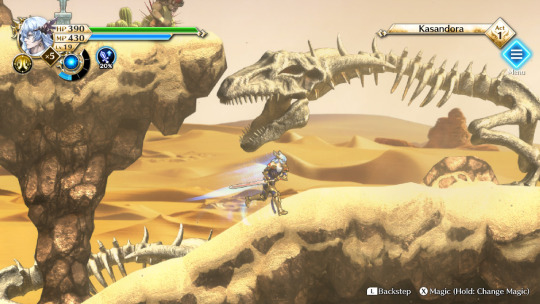
And the music, thankfully, absolutely soars. The awesome symphonic soundtrack by Yuzo Koshiro was one of the standout features of the 16-bit game, and it continues to impress in Renaissance. All the classic tunes have been updated and remixed for this version of the game, and numerous new tunes have been added. Better yet, you can choose to play with either the original 16-bit sounds or the modernized versions - and yes, even the new tracks are available in both styles. If you've never played ActRaiser before, this game is worth trying for the soundtrack alone.
Ultimately, Actraiser Renaissance is an experience that's deeper than the original, offering modern accoutrements, more complexity, and longer playtime in exchange for some of the charm and pick-up-and-play simplicity of the vintage game. It isn't necessarily better than its 16-bit predecessor, nor is this game a replacement for it. But that's OK. Instead, Renaissance stands beside the original as a welcome re-interpretation of a true legend of the Super NES era, and as a fine way to celebrate this genre-blending classic, particularly if you don't have an SNES or Wii Virtual Console version handy.
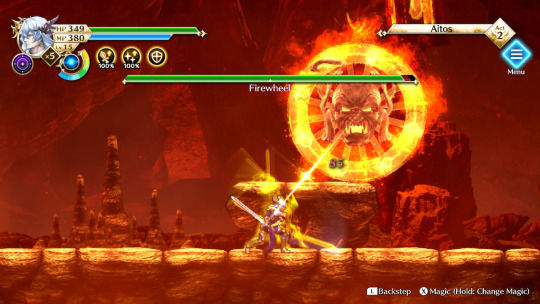
12 notes
·
View notes
Text
AA7 thoughts
So I just finished Spirit of Justice and then I heard about Ace Attorney 7 apparently in the works, so my brain decided this is the time to make up potential plot twists to be excited about that don’t actually exist. I know this is divergent from my usual fanart posting but here’s a very long text dump of some new stuff I’d be interested in seeing but will probably not happen because it is all very specific and caters to my own desires, probably not the fandom’s in general:
Phoenix is still there, but not as active as an acting defense attorney, though he’s still key to the plot (as a mentor, or to be used as emotional blackmail). He’s not playable (or if he is, it’s not for long), but more there as a plot point in a Maya sort of way (oh the turntables). This time, he’s the one under threat or danger. Instead of switching around from lawyer to lawyer, I think that Athena should undergo some more development as a main character this time around since Phoenix and Apollo have had their time to shine. The removal of Phoenix and being all alone, I think, would also be interesting in her character development
On that note, bring on the major character angst!! Having a big tragedy occur, with a fairly major character. Usually the tragedy pulled is a murder/death, but how about a different sort of tragedy-- a fate worse than death/on par with it to someone who is still alive? Someone is severely incapacitated, a psychological injury (classic old memory loss, or perhaps a genius who is reduced to a very limited mental capacity), coma, or even a temporary death (like with Petenshy, Edgeworth), or perhaps a kidnapping (not Maya this time, please). If it happens to a major character, it’ll have greater impact, BUT there’ll be fan riots if it’s not reversible. So have the tragedy with the character get resolved, but not in a deus ex machina way-- recovery is slow and angsty but filled with hope.
There’s often a focus on the past haunting you-- let’s try shifting this to the present! Building suspense on a case that is happening in real time-- I am fond of the idea of a serial killer on the loose in the present and the dread of suspense in present time throughout trials as they continue to kill and hinder key advances in solving the mystery.
Very often, there are personal ties in court-- both the prosecution and defense are tied together in some way in the past, resolving their own personal backstory. Instead of oneself, maybe let’s have some focus on a client instead? It might be interesting to see a lawyer get so deep into protecting a single client-- instead of a new client for every case, protecting a single person over multiple cases-- that they get roped into an outsider’s story instead. A little idea in my head is of playing around with maybe witness protection, or say (off the serial killer idea) someone is expected to be the next target for a murder and you are tasked with trying to protect them in real time (and then a tragedy happens to them that moves plot forward, bonus if players gets to build an emotional connection between you and the client).
In SOJ and DGS, the stakes were big on “saving the masses” and government reform-- the stakes can still be high, but instead of something lofty like reforming the world or community, instead it could focus on the relationships with the people immediately around you, protecting them, or just some good old self-preservation.
Newer characters like Athena being really fleshed out! Whether there are new or old characters, really build and explore the depth of their character beyond that of a plot point. Not just slapping on relationship labels that immediately trigger emotion but have no context beyond it (like the killing off “my best friend” Clay in DD, or the classic parental death). I thought the fleshing out of Dhurke and building an emotional relation to him in SOJ was a lot more effective in making it really feel like a tragedy than with Clay in DD.
For introducing any old characters, please show some personality changes due to age. Or, maybe! Even a 180 change from the personality from the original trilogy for intrigue-- what happened to the old person I knew (and have it be integral to the plot)? I know I griped about the old “ah That Event 5/7/10 years ago” past plot thing being used but I wouldn’t mind this being used as a part of plot development either
Maybe try to bridge the feeling of separation between the old trilogy and newer characters’ worlds by, instead of kind of sequestering them into their separate spheres of interaction to preserve nostalgia (like in Turnabout Time Traveler, where the old gang is all together in the same dynamic, Maya and Phoenix and Edgeworth, etc), have old trilogy characters interact with newer ones in significant ways and build their own unique bond. So, not just a passing mention where the old encounters the new, having the old interact with the new and build a bond through going through significant conflicts together (for example, this has already been mentioned but if Athena is the main focus of the next game, there could be an opportunity to explore this if she confronts Franziska in court!).
I know there’s already so many gimmicks added (Apollo’s perceive, Athena’s widget) but if there has to be something new added, instead of making it individual-specific, maybe have be similar to spirit channeling as a concept-- have it be a broad phenomenon in the world that plays a key part in causing a case, rather than a tool for discerning the truth of a case.
Or, if we’re sticking with the same gadgets/tricks, instead choosing to tamper more with the tools of the trade that were supposed to never lead you astray-- this has already been seen in DD, where Apollo’s bracelet led him to the wrong conclusion about Athena, and AA4, where evidence was tampered with. Perhaps instead of adding new gadgets, let’s manipulate, tamper with, lose, have it used against them in new ways!
The use of a civil case in SOJ was very much unexpected but in my opinion a very interesting one! Would be very interesting to see more in-fighting among the prosecutor group or within the defense attorney group and see how that moves the plot along. Messing more with the court system instead of adding new gadgets would also be interesting.
More threats during investigation, not just in court! Remember when von Karma tased you in the evidence room? Let’s have suspense in AND out of the courtroom.
I’m sure there’s plenty of interesting psychological phenomena that could be used to complicate court cases (for example, that use of Justice Minister Inga’s cognitive disorder in recognizing faces coming into play)!
Different approaches for moral ambiguity for clients using psychology-- we’ve seen this with defending clients who are actually guilty, or being blackmailed. I’d be interested in seeing a Jekyll and Hyde situation where 2 different sides of one person commit a crime, but one side is unaware of it-- and how a defense lawyer would handle this!
Exploring the plea for insanity in court! Double jeopardy! Escaped convicts! A murder whose trial to find a good jury has been delayed for a long time and is forced to find its resolution outside of court due to the murderer striking again!
Also, to pull in some stuff I read about elsewhere, after reading about moral psychology in Jonathan Haidt’s book The Righteous Mind and moral triggers that typically pull strong reactions (care, fairness, loyalty, authority, sanctity), I was also thinking about how ace attorney manages to build emotionally compelling cases in relation to this model. Ace Attorney imo so far has done pretty alright at hitting most of these triggers at some point to hype the emotion, but for the final case, it ends up being played in what I see as generally the same way (ex: character development starts from from my duty as a lawyer is my role as the defense/prosecutor into that of my duty is to find the truth, authority corrupt and that is bad, justice should be served fairly, I am loyal to my group of prosecutor/defense, also played with loyalty and betrayal in DD with Apollo and Athena splitting, also triggered sanctity a bit in SOJ with the religion, lots of other examples probably but that’s a few). I’d be interested in seeing these same moral triggers played upon in different manner for some variety! Maybe even pursuing some different themes than justice and truth and duty and all that jazz, but idk what else could be alright to explore cause the courts kinda embody all that and deviating to make a statement about other themes might not fit as well in the courts hmm
Also part 2, I wonder if there’ll be romantic undertone somewhere (or heavily implied) for any new or old major characters. Romantic love isn’t usually used with major characters as a plot point (usually platonic stuff, friendship, family, or duty to the truth is instead) but I’d think it’d be interesting if romance was used this time around as an emotional motivator to drive the plot
#ace attorney#ace attorney 7#aa7#i kind of wrote this all at once so it's probably really jumbled ahhhhfhhhh#basically i want that sweet major character angst#i might just end up making an AU with these ideas if they're not in AA7 because i want an excuse to see these in a plot hohohoh#anyway i'm trying not to have expectations but i got myself all excited anyway so here we are
48 notes
·
View notes
Text
Turles and Lord Slug Team Up Pitch
Introduction
Hello guys, after watching MasakoX's What If Turles Turned Good parts 1 and 2 [which act more like an origin story for him within the frameworks of modern Dragon Ball similar to Super Broly] I thought I would share an old headcanon origin I had for another Dragon Ball Z movie Villain, Lord Slug and how it could make for an excellent part in this What If story that has captured my imagination. Also, it opens up a lot of potential avenues for ood DBZ storytelling.
I know he's considered one of the most uninteresting Villains in the franchise since he is essentially King Piccolo from space, but rushed in an hour long movie. Let's face it, a lot of DBZ villains aren't inherently interesting characters and usually are introduced as Pure Evil tropes
Trope Talk: Pure Evil https://www.youtube.com/watch?v=1-XprjlATEo
Irrelevant backstory
very simple motivation
enthusiastic, zestful villainy
Pure self-confidence
Third -Act Breakdowns (where they are faced with what they truly fear and usually fail)
Afterward, they could be open to becoming a more nuanced character to explore as we've seen done time and again with cast of redeemed or evolved villains in Dragon Ball
A lot of the movie villains from the franchise would be more interesting if they weren't rushed or were expanded on and boy does Lord Slug bring a lot to the table if he is expanded on.
1) You could have Turles and Lord Slug form a dynamic duo that counterparts Goku and Piccolo. Turles is a trouble-making youth-filled underdog who has taken a shine to the crabby old man that is Slug. Turles could use a lot more modern methods to contrast Slug's far more traditional warmongering that he's developed over the centuries. (They did it a little in Xenoverse 2, but you could really expand upon it in a MasakoX styled What If) Plus, the Tree of Might likely has the ability to restore Lord Slug's youth since it canonically resurrected fossils, so Turles literally has the solution to Lord Slug's main problem plaguing him and is an open-minded businessman by nature. This hypothetical team-up of working together to gain more power, invade planets for their resources and overthrow the Universal order by killing Frieza before returning to enemies, acts as an inverse counterpart of Goku's and Piccolo's initial alliance against the Saiyans invading the Earth interfering with Piccolo's own conquest, but opened the doors for change in him and others.
2) Most likely these 2 would start off as enemies and have their forces face off against one another, but this struggle is a good thing in the long run because they could potentially provide each other, their own personal Third Act Breakdowns or at least teach each other recognize their own flaws and weaknesses to help each other grow as characters.
Lord Slug's backstory, retooled
Planet Slug
The most fun thing I found was that they gave Turles a proper origin story to build a character around, well I have a suggestion for a similar concept for Lord Slug that I think you guys could use in many different ways, but before that. Here are the facts. In the backstory I found in supplemental materials, it is stated by Guru that Lord Slug and other Evil Namekians could have possibly escaped the crisis on Namek and moved to far-flung planets in other parts of the Universe. One Super Namekian named himself after the Demon inhabited world he found himself on, known as Planet Slug. And judging from the movie, Planet Slug is most likely an icy or snow-covered planet since the Demons needed special suits to withstand the Earth's temperature.
By the way, I imagine that Planet Slug and its people could have a Mongolian theme. (I have a sketch I did for an alternate costume for Slug, but I don't remember how to post atm)
If say Lord Slug came to this planet and eventually took it over in the King Piccolo style, then I could see him having birthed a clan of Evil Namekian children to help him in this endeavor. So let's say there are about as many Namekians children as Guru or King Piccolo birthed, then they are likely different clans of Namekians on the Planet, including a Dragon Clan member capable of creating their own set of Dragon Balls. In this way, Planet Slug could act as an alternate substitute for Planet Namek, but one closely resembling how the team initially pictured Namek as a planet full of evil Piccolos, instead of the peace-loving farmers of Namek. Now, why would Slug be in space expanding his Empire and searching for Dragon Balls when his planet likely already has a set? In the movie, it's best not to think about it, but here is my idea.
Why Lord Slug is REALLY in Space
One of Lord Slug's offspring usurped him from the throne due to his old age and sickly body. So Slug was humiliatingly forced to flee his home or was looked down on as a non-threat banished him and his most loyal men off-world to live in shame and to never be seen again. So he is conquering other planets, partly because he is a refugee, but mostly because he is overcompensating for his lost and trying to help his ego by living in denial and reassuring that He is the Baddest Baddie who ever lived and terrorize/kill those weaker than him as he ever expands his empire, lamenting his old age and sickened body. He believes that if he was in his prime, he could take his throne back no problem and make them all pay for wronging him. Luckily, Slug doesn't need the Dragon Balls to regain his youth. If the Tree of Might's Fruit is capable of reviving fossils, it should be able to restore the Super Namekian to his former glory once again.
Turles's Crusher Corps vs Lord Slug's Army
A fun way they could introduce the factions to each other is as competition for a lush planet. Turles wants it for the Tree of Might, and Slug wants to freeze it for them for their conquest. They both are in each other's way, so they all fight it out. I think Slug has stronger minions, but Crusher Corps have better teamwork, and with Turles being in prime fighting condition, he would tip the scale in their favor much like Goku did in the movie.
At first, I thought Slug wouldn't be much of a match for Turles in his old and sickly state, a little trouble sure since he is the strongest, but that aged body wouldn't do him any favors. However, the first Google search result I got on Old Slug's Power level said he was at 79,000 so he's stronger than I first thought. (I thought he was around Nail's power level roughly in the 40,000) I also heard that Turles was around 19,000 but by the end of the movie was like 300,000. These power levels don't mean too much when reimagining the stories, just that Turles might have more of an uphill struggle. So, Turles would first have to eat some Fruit to win in a landslide and hopefully, the Terrafreezing process didn't ruin the Tree of Might's process.
Right before the killing blow, Old Slug might've mentioned something In desperation to save his own life. He could've brought up the Dragon Balls on his home Planet Slug/ Namek could grant any wish he wanted. This is just enough to stop Turles from following through with his attack, but it takes a little more coaxing for Slug to sell the legitimacy to Turles. A part of Turles thinks this might just be hogwash, but if this is anything like the Tree of Might, this could be a huge find. Another game-changer. He has his men take Slug with them as he checks in with the Heaters' database and finds there could be a kernel of truth to this tall tale. So Turles generously spares the old Slug's life for this useful tip which is met with some impatient ire.
If you hate being old so much, why don't you just use these Dragon Balls of yours to make yourself young again? -Turles
I would if I could, but... but I can't. I've been banished from my homeworld by my own children after they usurped me from my throne.-Slug
hahaha So you're just some washed-up old geezer trying to feel tough by throwing your power around at a bunch of weaklings. -Turles
Watch it! If I was in my prime, I wouldn't have ever let that rebellion get that far and even made short work of you and your men. If it weren't for that Fruit of yours, you'd be nothing. -Slug
WHAT WAS THAT. (composes himself) Interested in the Fruit are you, well I am not naive enough to let you ever sink your rotten teeth in one. At least, not for free. We, the Crusher Corps, are branched off of the Heaters' group who are known to deal in intelligence. If you have some more valuable information to pass on then, I could be convinced to trade off a leftover Fruit from our latest venture. Do you have anything else to offer me, old man?
(Slug’s low growling sounds are giving Turles just the biggest shit-eating grin on his face)
Slug could tell Planet Slug's coordinates, could act as their guide, or how to use their Dragon Balls, or even that they need a native speaker to use them and a password.
Turles throws him a Fruit as he is a businessman and honors his deals. This not only works in reviving the Elder Namekian, but the results are far better than expected by restoring Slug to his prime. Turles is both impressed and a little unnerved by this so he opens up a dialogue as he scans Lord Slug's new power. (he thought it would add a few decades back onto his old life since he seemed ancient, but it straight up made him young again) They discuss what had just happened and Turles's operation using the Tree of Might's Fruit to amass enough power for him and his men to kill Frieza and possibly overthrow him. Lord Slug in the meantime has been enjoying his youthful appearance and renewed vigor during the conversation, not looking Turles in the eye, but still expressing interest in this operation and compliments the plan. Turles offers a proposition to Lord Slug to join them on this endeavor if he helps them get those "Dragon Balls" he mentioned right before.
That's right. You're interested in the Dragon Balls, are you? Well, I am interested in that Tree of yours. It could keep someone young and strong forever, and this whole operation of yours is simply remarkable! -Slug
So you're in? -Turles
Remarkable enough for me to take it for myself! So I'll be doing just that! - Slug
Round 2 Super Namekian Rampages
The Super Namek overwhelms all of them, even Turles, after just eating a bunch of fruit, the gap is just too wide. He sadistically tortures them and strikes fear into their hearts. Turles isn't just put on the backfoot, he ends up on the brink of life and death. He needs to reach down deep, and something in him snaps, could be his Saiyan pride, could be becoming helpless and at someone else's mercy, could even be one of his men, that unbeknownst to himself, he had grown fond of perished, his regret for overly relying on outside gains to accomplish his ambitions. Don't know, don't care, but something doesn't sit right with Turles and this something acts as the catalyst for him to transform, but not into the traditional Super Saiyan we've all come to know. No, Turles goes into the False Super Saiyan state and overwhelms the Super Namek almost beat for beat like FSSJ Goku vs Slug from the movie, but this time, it lasts the duration of the fight. It's more of a SSJ Goku vs Frieza kind of fight with Turles's victory.
Turles diet of Tree of Might fruit has affected his body's genes and so when he transforms it's not the traditional SSJ form like everyone else, but the False Super Saiyan state that Goku used against Lord Slug. (The Saiyan loses their pupils and also uses SSJ's original color scheme with the flickering red and black hair and the orange skin with a lingering Aura effect) They could have a lot of fun with the benefits and drawbacks this form and its potential evolutions could have. False SSJ potentially falls into the theme of using Fruit as a shortcut to power vs earning the power legitimately or as a simple means to contrast with Goku.
Post Fight ~ Alliance?
Slug doesn't die though, or if he does, Turles is smart enough to revive him with the Tree of Might's extract in a similar way as the fossilized twins were. The reason is simple, Turles believes that Slug's knowledge of his people is going to be essential in the nearby future, and since he's shown whose boss by dominating the Super Namekian, they can now work together to overthrow stronger enemies like Frieza by using his Planet's Dragon Balls. The Crusher Corps gets a guide and an ally; Slug gets his revenge and the prospect of taking Frieza's empire for himself by joining this operation is too much for him to pass up. This is a temporary truce to defeat stronger opponents and gain power, but once that is over, they are going back to killing one another similar to how Goku and Piccolo formed an alliance against the Saiyans invading earth.
1) A Super Namekian could exploit their race's fusion ability through some method of Mind Control like in the original Broly movie. So Slug or his evil offspring could literally absorb one another or even someone as powerful as Nail or Piccolo if the influence is strong enough to join together. And Turles with the Heaters' resources might just be able to provide a means to provide Slug this, with some precautions of course.
2) Slug might have knowledge of Kai and Demon Realms considering he is both an older Namekian like Guru, and the fact that he Planet Slug is literally inhabited by Demons, a different breed of Demons, but still Demons nonetheless. In the games, the Tree of Might's Fruit had its effects amplified in the Demon Realm, but the same might be said if the Tree is planted on the World of the Supreme Kais or Beerus' planet. It's just a possible option for later down the line, but if there was ever a planet that could sustain that Tree and boosts its effects it would be one of these places.
This is it, I know MasakoX likes to do the space opera thing with multiple factions and also like to mix things up from the original story from time to time, so I thought Planet Slug would be an interesting means to do so and giving Turles a partner to bounce off of is typical Toriyama writing, could even open up new avenues to explore.
Am I expecting this to happen. Honestly, I have low expectations MasakoX and his team would do this and they got their own plans of inserting Turles into the main story likely connected to the character in the hood (who is probably Zamasu for some reason like in the Gero What If) or one of the Saiyans from Turles' team or even eager to get him into the main story with the Z-Cast, possibly trying to win Gohan to his side, but getting converted by him like what happened to Piccolo, but I don't mind. My expectations are low, but my hype is through the roof, and needed to share my fan theories with someone.
#dragon ball z#dbz#dragon ball#lord slug#turles#slug#tree of might#masakox#what if#dragon ball what if#false super saiyan#false ssj#super namekian#super namek
10 notes
·
View notes
Link


Blue Planet is a compelling RPG journey into humanity’s precarious future on a distant waterworld where political unrest and a hungry alien ecology threaten the nascent colony effort. A planet where GEO marshals struggle to maintain peace, Incorporate mercenaries wage amphibious proxy wars, and native insurgents fight for their adopted world. A frontier where human desperation and corporate greed ravage an uncanny ecology, threatening to plunge humanity into a war of survival with an ancient, alien legacy.
Though the original Blue Planet predates many of these titles, the setting is evoked by the movies Avatar, Blade Runner and Outland, the television series The Expanse, Firefly and Earth II and the books Legacy of Heorot, Songs of Distant Earth and the Mars Trilogy. A reviewer once gave a glib but accurate elevator pitch for Blue Planet as "Space marshal Cowboy and his cybernetic dolphin sidekick fight eco-crimes in alien Hawaii."
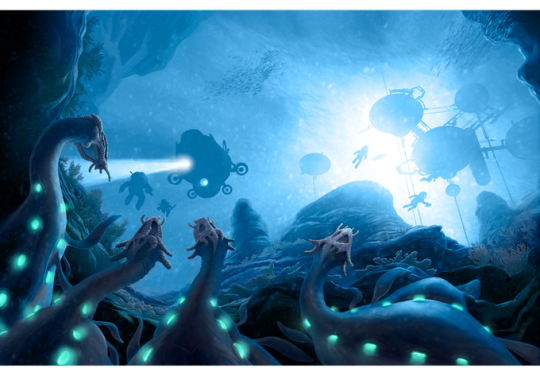
The Full Premise
Blue Planet's uniqueness and enduring appeal are in its deep, realistic, hard science fiction setting, and to really describe it requires more than a few sentences. For those new to the waterworld, we recommend exploring the more detailed premise here.

This campaign will fund the production of a new third edition of the critically acclaimed Blue Planet roleplaying game. We’ve brought Blue Planet to Kickstarter because we're excited to make the definitive edition of the game, but we need your help to do that.
We want to design a uniquely beautiful, full-color, two-volume, 600-page masterpiece, overflowing with evocative art, captivating text, and exceptional production values. We want to make the books themselves works of art with UV cover highlights, endpaper maps and page-marking ribbons. We want to fill them with a new rules set, stunning art, expansive color maps and compelling new locations, social structures, future technologies and alien secrets.
These features and content exceed our capacity to resource on our own, so we are here asking you to join the Blue Planet team and help us make the new version of this classic game truly exceptional.

Download the Blue Planet: Recontact Quickstart Guide here. This 80+ page, full color primer is free and contains the new version of the rules, a setting sampler and a demo scenario called "Trouble in Paradise," complete with ready-to-play characters.


The Recontact project includes
• An extensive evolution of the core mechanics, taking advantage of two decades of RPG development. The new system can be found here in our free, 80+ page Recontact primer.
• All new, full-color artwork bringing the waterworld to life in stunning, evocative imagery.
• Full-color world and regional maps, including submarine geography, redesigned and rendered by professional cartographer and game designer Mark Richardson (Green Hat Design).
• A series of campaign archetypes to help moderators jumpstart their games in the vast adventure space of Poseidon (see below).
• Updated speculative technologies.
• New sociopolitical systems, organizations, institutions and conflicts.
• New locations, settlements and facilities.

The Recontact project does not include
• Fundamental changes to the core sociopolitical tensions - the themes will remain staunchly pro-environmental and anti-colonial.
• Timeline advancements - the setting was originally - and intentionally - poised on a sociopolitical precipice, rife with plot and storytelling potential, and we want to maintain that same narrative tension.
• Global rewrites of the setting material - though updates, sensitivity edits and additions are being made throughout, we believe Blue Planet’s deep setting is why the game has endured, and so we are not making major alterations to that essential content.
A word about the delivery date
We know a reward delivery date of October 2022 seems unexpectedly far away. Though we intend to deliver Blue Planet sooner, our experience, and the last year in particular, have proven an essential truth about Kickstarter management - set a generous delivery date, then add six months. We hope this date does not discourage folks from becoming backers, but instead demonstrates our commitment to realistic planning and transparent communication.

All reward tiers (digital and physical) will receive PDFs of the out-of-print Blue Planet books the day after the campaign ends. Single book pledges will receive the corresponding v2 PDF, and book set pledges will receive copies of everything ever published for the line. All 10 past Blue Planet titles - over 1700 pages of waterworld adventure - as immediate rewards!
First edition Blue Planet, Archipelago, Access Denied, v2 Blue Planet Player's and Moderator's Guides, Fluid Mechanics, First Colony, Frontier Justice, Natural Selection and Ancient Echoes.


Blue Planet has received broad acclaim, particularly for its deep, detailed, and realistic setting, and has remained well regarded since its original publication. However, that publication was almost 25 years ago, and in the intervening decades, all versions have gone out of print and game design has evolved dramatically. We are therefore excited at the prospect of giving the game system an overdue overhaul and the opportunity to share Blue Planet with a new generation of players.
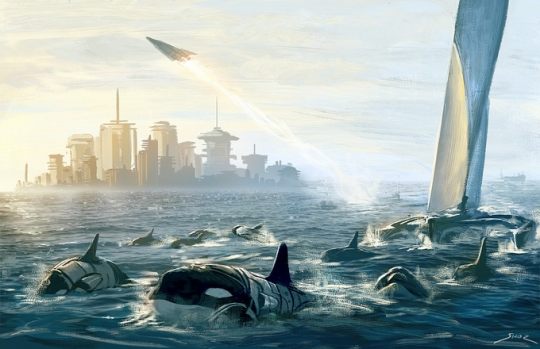
More personally, Blue Planet features critical environmental themes, presenting a precarious future threatened by the dire consequences of ecological collapse. If issues like biodiversity loss, ocean acidification and climate change were only obscure concerns within the scientific community 25 years ago, they are now clear and present existential threats to the human species. This new edition will let us add our own small voice to those demanding true stewardship of our original blue planet.
Compelled by these reasons, the original creators at Biohazard Games have teamed up with publisher Gallant Knight Games to produce a modern edition of this classic RPG.
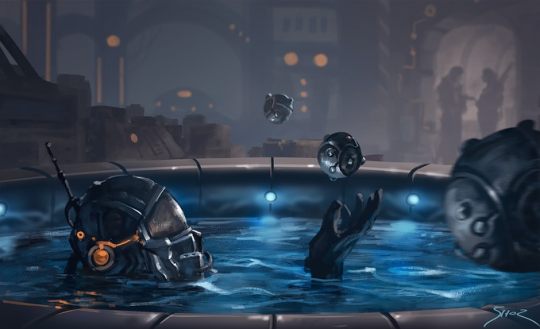
Recontact is the in-game term for the fateful day in 2165 when the UNSS Admiral Robert Perry entered orbit around Poseidon, “reestablishing contact” with Earth 69 years after the original colonists were abandoned. Given that more than two decades have passed since the publication of the first edition of Blue Planet, RECONTACT seemed a fitting subtitle for this new version of the game.

Anyone familiar with Blue Planet v2’s Synergy rules will recognize the new system as a modern evolution of those mechanics, sharing a little of that design's genetics and the same intent to support the hard science realism of the setting. Players will also find the new system is simultaneously simpler and more robust, while supporting richer, more evocative character creation that's focused as much on who characters are as what characters can do.
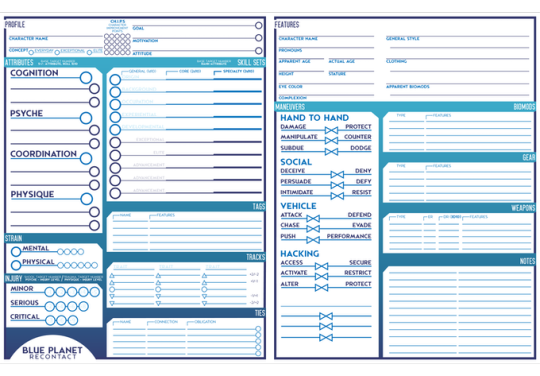
Characters have 4 attributes with optional foci and up to 8 skill sets - areas of expertise based on player-generated descriptors that evoke a character’s origins, training, occupation and experiences. The core mechanic is roll ≤ (attribute rank)+(skill set rank). The roll is made with either 1, 2 or 3 d10, depending upon whether the general, core or specialty in a given skill set is being used. For those who know v2, these elements should seem familiar. There are fewer attributes, but they work similarly, and the variable dice pool is a streamlined take on the aptitude mechanic. The skill sets are simultaneously simpler and more robust than the long list of specific aptitudes and skills in the 2nd edition.
Blue Planet does remain a realistically dangerous game, keeping the wound levels and trauma tests from the 2nd edition. Weapons and sea monsters are therefore quite deadly, so characters should try to avoid getting shot. Or eaten.

The new mechanics also lean in to the qualitative roleplaying aspects of modern character design, providing Tags, Tracks and Ties unique to each player's character concept and each moderator's campaign. The emphasis is as much on who a character is as what they can do.
Tags are specific consequences, benefits, convictions, motivations or other active descriptors that a character incurs during their adventures - generally the result of narrative events, important tests, fallout from interactions with other characters and injuries.
Tracks model the range of specific character emotions, attitudes and mental states. They are usually campaign or party specific and can be offered by the moderator or created by the players for their party or their individual characters.
Ties describe a character’s primary relationships, identifying the people and organizations to whom the character is connected, as well as the nature of the obligations they must meet to maintain those relationships.

The only consistent criticism Blue Planet has received over the years is that the setting is so vast and wide open, it’s often challenging for game moderators to know where to start. They struggle to choose a single campaign current from among the sea of ideas in the setting. Blue Planet: Recontact will therefore provide a diverse set of campaign archetypes to provide ready-made options for GMs new to the game.
It’s common practice for RPG books to present a range of character archetypes, providing players with detailed examples of the kinds of PCs available to play. These campaign archetypes are similar in that they offer guidance for a variety of different adventure types that can be run in the world of Blue Planet, providing GMs with starting points, directions and enough details to get a variety of different campaigns underway. Each archetype outlines a premise, PC suggestions, unique NPCs, key locations, resources, themes, and plot threads from which a GM can build their perfect Blue Planet campaign.
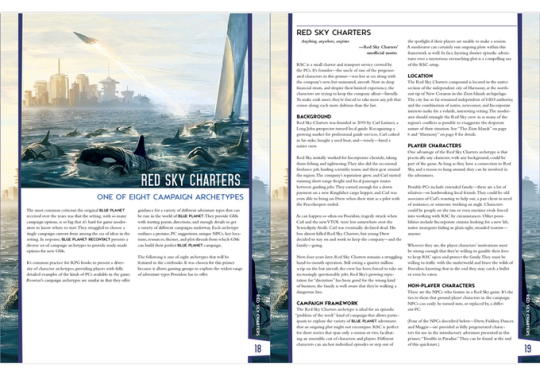
Read the full first example - Red Sky Charters - in the Recontact Primer here.
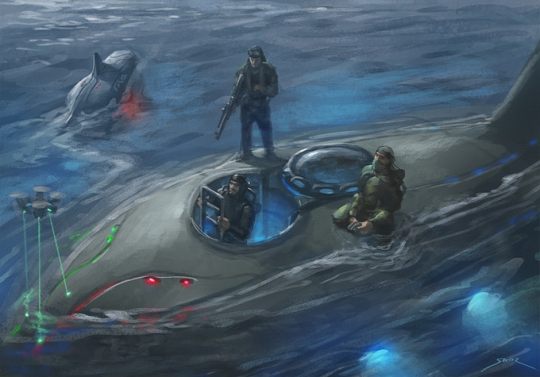
Kickstarter campaign ends: Wed, May 5 2021 3:00 AM BST
Website: [Biohazard Games] [Biohazard twitter] [Gallant Knight Games] [Gallant Knight twitter]
28 notes
·
View notes
Text
Perhaps a little coaxing is needed...
Good evening my literary friends,
I am hoping to find a suitable partner for specific cravings and ideas I have in mind.
My introduction will be brief and a bit more to the point than usual. I am quite thorough and detail-oriented when it comes to being a writer, including some of my rules and preferences. However, since I believe it to be quite a hassle to go through every point I’m making, my ad will be a bit more compact.
A brief recap: You can call me Imp; I am in my twenties and a student, striving to become a part-time freelancer as well. My main hobbies are photography, traveling, drawing and of course, the art of writing. Currently, I reside in Europe, so my timezone could differ from yours, unless you are also from a similar region.
Be sure to read through my ad to see if we’re compatible. Too many times I’ve encountered cases where the inquirers skimmed through all of the info and upon messaging me, were surprised to learn that we weren’t a match from the beginning. So if you haven’t properly read my ad, I’ll know. I’d like to urge everyone to stick with it so there won't be any misunderstandings and not waste everyone’s time.
————————
Me, myself and I
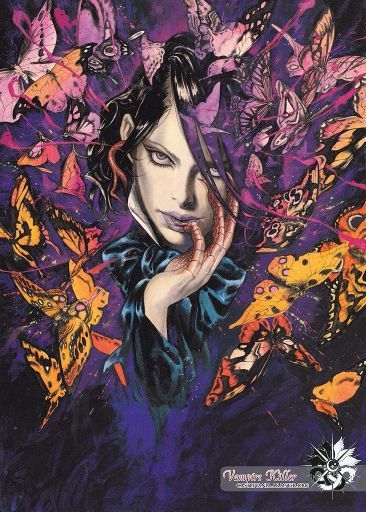
(art by: Ayami Kojima)
♦ Nickname: Imp
♦ Experience: 12 years and counting
♦ Style: 1:1 with the inclusion of doubling
♦ Rating: Mature
♦ Roleplaying Platform: Email and Google Docs
♦ Chatting Platform: Email, Google Hangouts or Discord
♦ Pet peeves: Slice of Life
After finishing the game of Resident Evil 8 Village, I was struck by yet another muse.
I am currently looking for either a pre-existing canon inspired roleplay, or, something completely original. Be sure you are above the age of eighteen, preferably 21 and upwards. I will not accept any inquires from minors - this is not negotiable.
What to expect
♢ Content: Mature. I am more interested in darker things like horror, occultism, the supernatural, you can maybe guess where I am going with this. My limits are few, safe for a couple of minor pet peeves that I have, I am pretty much open to some experimentation; such as violence, gore and sexual themes. When it comes to heavy scenes, I will not fade to black, unless it serves no purpose to the story. Not a huge fan of censorship. However, I will not force or push my partner into something they are not comfortable with. If you want to know the extent to how far I am willing to go, what sort of content, or how graphic my writing will be, you can ask me directly.
♢ Rating: I have little to no issues with delving into more sensitive topics. Since reality is often stranger than fiction, it is very interesting to explore all sides of human nature, including the less comfortable subjects such as psychology, crime, etc. But I also like to remind that this is a world of fiction and no one in their right mind would condone such things in real life. The world of adults is not easy to handle, but it sure is interesting to explore. So if you are a gentle soul and can’t take the heat of more serious moments within the roleplay, be it a character going through trying times, etc; this might not be ideal for you.
♢ Writing: My texts are considerably lengthy, detailed, and elaborate. Third-person is usually my preferred way of playing my character unless there’s a special case where an exception can be made. Word count usually fluctuates, though I have a standard form of 400-500+ words per reply. It also highly depends on the given situation.
♢ Romancing: I admit to being a hopeless romantic. There’s nothing more enjoyable than witnessing good and powerful chemistry between two characters. Preferably I go for the usual MxF pairing dynamic but I am also open to FxF and MxM, should it feel more fitting. While doubling, I can write the character/love interest to my partner’s desire, but I always aim to stay true to their personality and character. I hate nothing more than forcing characters into a relationship, especially if there’s no spark, so I won’t respond well to being pressured into letting characters act out of their personality. It’s just not realistic. As for smut, or what have you, I have no issues with adding a few spicy scenes, sometimes even drawing them out of our pleasure. When there is, however, a running theme where sexual themes are taking the focal point of the plot, it can become quite boring. It is never the center of any of my roleplays, so be warned.
♢ Plotting: I am fairly quick when it comes to building new characters, concepts, premises, storylines, backstories, etc. It allows me a certain latitude. Feel free to communicate your ideas and thoughts with me. I am happy to chat, even when it doesn’t involve the roleplay directly. Though this is a hobby, I am still extremely passionate about good storytelling and interesting character arcs. I hope to meet someone who is just as enthusiastic and willing to put in the same amount of effort. If it’s only me who’s pulling all the weight, I will lose interest and feel forced to end the correspondence.
No gos
♦ Won’t do: Pedophilia, Necrophilia, Bestiality, Scat, Vore, Toilet Play, etc. I am sure you can also think of many other strange fetishes that have developed over the years spent on the internet.
♦ Won’t write: The idea of supernatural beings trying to fit into human society. The typical bully x victim storyline. The run-of-the-mill vampires vs werewolf plot. BDSM centred stories. Slice of life. Flawless or excessively flawed characters.
What I expect
♢ Literacy: You should at least have a decent grasp of basic grammar and coherency in your spelling.
♢ Flexibility: Since we all have lives outside of the roleplay, we both need to be flexible. Sometimes our schedules may differ, and if life is currently intervening, we can take things a bit easier. Plus, I can’t always respond every second of every day, either. This should be considered a hobby and not a job. If a hiatus is on the rise, there is no problem with putting things on ice until things clear up.
♢ Experience: And by that, I don’t mean how many years you’ve roleplayed, rather the experience that comes with age and emotional maturity. Especially if you want to write stories with grit.
♢ Open to doubling: Quick explanation. Doubling is when we play two main characters each. The dynamic is as follows; I write your chosen love interest against your main character while you do the same for me.
♢ Long term: Only long-term partnerships.
♢ Sharing the spotlight: Don’t forget, this is all about you too! Let me know all your specific cravings, interests, or wants that you want to be included into the roleplay.
Cravings
♦ Urban fantasy: Supernaturals, demons, spirits, vampires, you name it. I’d be more interested in something original and unique, especially when it comes to vampirism and demonic entities.
♦ Dark Sci-Fi: So this is a bit inspired by Resident Evil. A world where monsters become a vicious reality, generating fear among the people they come in contact with. But as it turns out, these monsters are not supernatural, but rather infected or mutated by a virus that cannot be explained.
♦ History, mythology, and folklore: An interesting take on the historical timeline, where legends and myths were once a reality. However, their existence was greatly misrepresented in the storybooks, sometimes even completely distorted. Our characters could be accidental time travelers who have been sent from the future to see it with their own eyes. Inspirations are mostly Slavic, European, and ancient folklore from all over the world.
♦ Crime with a dark twist: Mafias, organized crime, and corrupted politicians run this town. All of them have one thing in common. A particular drug that grants humans superhuman abilities; but at a cost. The drug will turn force the users to reject their humanity to instead embrace their monstrosity.
Canon & Fandoms
♢ Castlevania: Rather the original games than the Netflix series. But I am also not opposed to tackling the Netflix universe.
♢ Devil May Cry: Every game is game. Except for the reboot. Never played that one.
♢ Invincible: Not so invincible.
♢ Resident Evil: Village is one of the best games I’ve ever played. Periodt.
♢ Harry Potter: Next gen anyone?
————————

If you made it this far, I am glad you managed to hold on, lol. If you found what I wrote, agreeable and have a similar interests to mine, feel free to message me on this email adress.
You can also contact me via DM on my Tumblr blog, though preferably, I would rather be more receptive on Email since I am more active there. And it’s a lot more personal as well.
Email: [email protected]
Hope to see you there.
I wish you all a lovely day my fellow readers!
-Imp
#roleplay partner wanted#roleplay partner needed#fantasy#writing#creative writing#mature rp#gothic#supernatural#castlevania#devilmaycry#resident evil#invincible#harry potter#original#original story#roleplay#paragraph#horror#dark fantasy#oc x canon#oc x oc rp#drama#adventure#plot
12 notes
·
View notes
Text
BUILDING THE MONOLITH
Group project completed by: Erika, Matteo, Tayler, Isobel for CUST-2236
Coordinates XYZ: 355.636 / 63.000 / 550.381
After receiving our assigned group for the project, I reached out to my group members via email and the discord channel. We decided that the best way to communicate would be in the discord channel, as most of us seemed to find it a good central space to keep track of as opposed to email chains. One member of the group did not respond to any correspondence, but there was an immediate willingness from the rest of the members to support each other.

Pictured above: Everyone is ready to collaborate! Updating Isobel so that we’re all on the same page.
It was apparent that Matteo seemed to have the most experience out of the group, and he took it upon himself to find a location to start construction. This was helpful because it gave us our first goal: to reach the central meeting point. This proved more difficult than I was anticipating, which I’ll discuss in further depth in my analysis.
By the time I reached the meeting point, Tayler had begun to set up a “safe house” where we could sleep through the night to avoid enemy confrontation, and store supplies. Tayler also helped establish me in the game by teaching me certain mechanics, providing me with armour/food, and giving suggestions as to what tasks I could work on.

Pictured above: I made it to the meeting point! Tayler helping me.
Without Tayler’s help, I don’t think I would have been able to contribute as much to the group as I eventually did. Although I don’t think Tayler had a specific part of the treehouse that was “his” build, the support role that he played was a big part of the group’s success (and mine personally). He kept our supplies replenished, built beds and paths, and established our original safehouse. This role stood out to me because it was all for the betterment of the group.


Pictured above: Some resources collected primarily by Tayler, entrance to the safe house constructed by Tayler. We used this to get through the nights safely and store materials
Early on, we decided that a fun way to put a twist on the treehouse concept was to make one central tree that attached to an extensive network of smaller treehouses. Matteo started the base of the treehouse, which was helpful for those of us with less experience building. Once that had been constructed, we were all able to start contributing to the overall project. There was no strict plan or division of labour; instead, everyone contributed freely to building up the tree-village by adding limbs, houses, and bridges. I think that our plan for the project really complimented our group dynamic: it was a collaborative effort, but everyone had freedom to explore creatively and build their own ideas. For example, Matteo created a dining area, Isobel created the first greenhouse, and I made a cabin with an attached hot tub deck. In this way, the project had an aspect of each of its members.




Pictured above (in order of appearance): Treetop view of Isobel’s greenhouse, Matteo’s look out, and my connections; new home base in progress, my hot tub deck; bridge entry to the village.
My house and deck area are the most obvious part of my work, but in reality I am most proud of my effort to connect the villages via branches and bridges. It took a lot of trial and effort, but I think that it was a huge part of what gave our project its shape and look. When I first started building, Matteo’s foundations were all separate. I spent an entire day building up scaffolding to connect those areas with branches and bridges. Once I had roughed in that concept, other members were able to add on and the village really began to take shape.


Pictured above: Standing on the scaffolding used to build connections, you can see one of my bridges underneath; treetop view of the connected village.
In the end, I was quite happy with how our project came together. The connected treehouses reminded me of the Ewok village from Star Wars, and I like that there are different themes that would complement a real life community. If we could have kept building indefinitely, I would have liked to eventually connect Matteo’s big main tree to the village with a treetop bridge. I think that the connecting tunnel system and mainland bridge were a good way to tie everything together with the time we had.
1 note
·
View note
Photo

The Plutonia Experiment
32 maps megawad.
By the brothers Casali.
1996.
https://doomwiki.org/wiki/The_Plutonia_Experiment
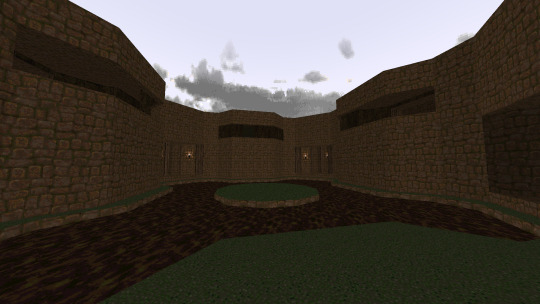
Level 1: Congo
Iconic beginning that presents us one of the most popular tricks of Plutonia: Chaingunners, Archies and a lot of pain. Pretty hot start that delivers quite greatly.

Level 2: Well of Souls
An elevator styled entrance that delivers quite the punchy level with some awesome ‘‘congo’‘ vibes more than the actual congo level.

Level 3: Aztec
Iconic beginning that presents us one of the most popular tricks of Plutonia ''invisible bridges'' I'm not a fan of them but I can see the charm in this first level.

Level 4: Caged
Surrounded on all sides and ready to die The first level of Plutonia that presents the classic style of difficulty but keeps a nice balance between exploration and combat.
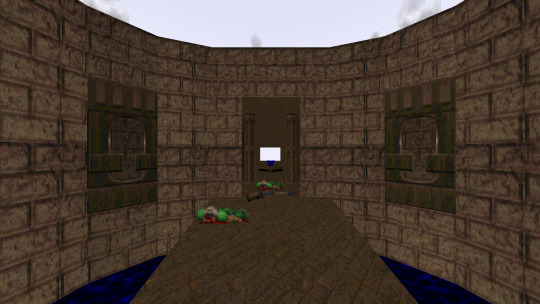
Level 5: Ghost Town
We are moving to a tighter and more traditional format but one that remains constant though somewhat simpler.
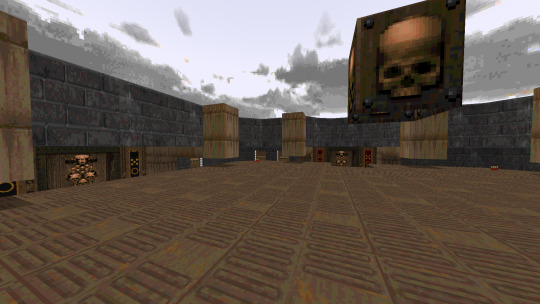
Level 6: Baron's Lair
One of my favorites. A medium size level but with a more interesting layout that reveals different areas of combat and a dynamic and entertaining progression.
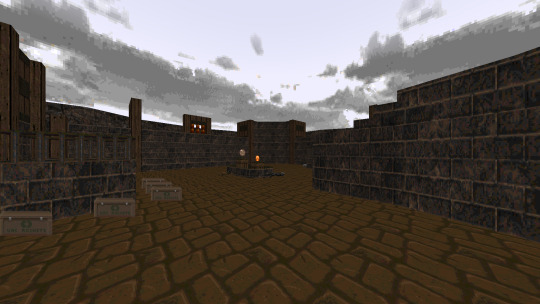
Level 7: Caughtyard
Another of my favorites and one of the icons of the set. This is a simple square map sand style but with a pretty hot gameplay that will take blind-players by surprise. It still has a good quality of play and is fun to play with at all times.

Level 8: Realm
A bit punishing at times but with a fluid design.

Level 9: Abattoire
Quite open and with a more bloody combat. This is one of the first big maps and takes us through a somewhat different but acceptable adventure.

Level 10: Onslaught
With a design that makes more use of exteriors, this level combines a beautiful design with an attractive and challenging gameplay.

Level 11: Hunted
Oh boy. This is probably one of the most iconic maps in history. A great labyrinth where the only enemies are nothing more and nothing less than Archviles. What does of this one a quite destructive and frustrating adventure for moments, but the simple originality of the concept does of this one a fascinating map.

Level 12: Speed
Moving is the key, although not as fast as the map indicates. A high design and a few surprises make this a nice and drastic adventure.
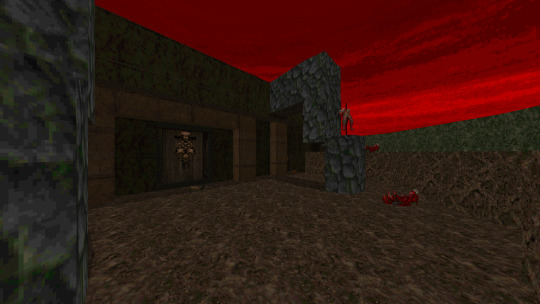
Level 13: The Crypt
Towards the depths of a tolerable map.
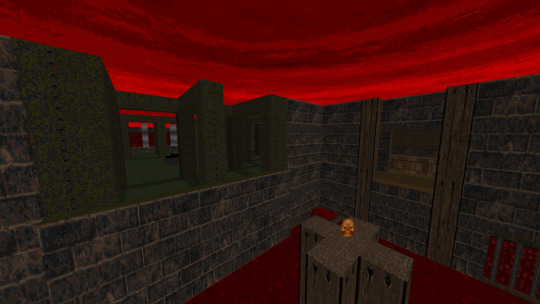
Level 14: Genesis
Smaller than normal but with a closed circuit design that allows constant movement and gameplay that flows like the wind.

Level 15: The Twilight
(Exit to secret level)
Things get hot. We need good moves and a bit of strategy to advance a more tactical map and with a less merciful gameplay but always maintaining a solid quality.
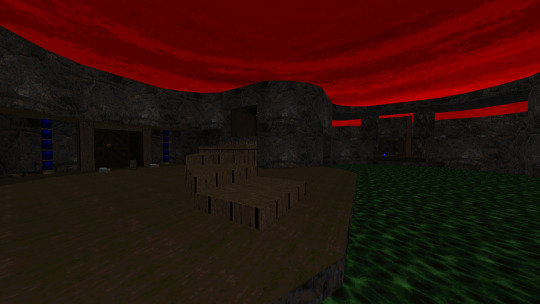
Level 16: The Omen
A small level with a lot of intensity. Developed in a simple system of capture of keys which are at first sight and without major problem. The combat, however, is developed as a system of constant surprises in which the player will be ambushed at every given opportunity, creating an intense level that despite having a duration of about 6 minutes manages to deliberate an entertaining gameplay with a design that, even if it is simplistic, does the job in a good way. Some areas can be a bit annoying (deliberately) and makes it a bit difficult to get around, but Plutonia has far harsher maps and this one feels more like an intermission that lets us rest a bit.

Level 17: Compound
Another short level that follows the same visual theme of this chapter. What we have here now is a more intricate design with an entertaining layout that combines a bit of traditional style with certain abstract structures. With a more fluid but equally hot combat, this is a fast level that enjoys a good flow.

Level 18: Neurosphere
Interestingly fluid, dynamic and quite intense without necessarily being destructive. This is a level that has a very entertaining flow that allows to appreciate the combat of a more dynamic way at the same time that it stays stable and balanced before the player, taking into account the difficulty of the most famous maps of this game. I could say that this map feels more like a MAP01, or at least it could have been very successful as the first map.

Level 19: NME
Hot and short in size, but well packaged. That sounds weird. This is a pretty intense map that sees us in a tight fight and requires a little more anticipation to survive, as well as a few surprises that can take us by surprise. With a nice design but a bit stressful combat, it is a solid map. All the maps have been pretty solid, actually.

Level 20: The Death Domain
Something a little more traditional but welcome, with a good collection of Chaingunners and a circular but constant layout.

Level 21: Slayer
A circular map with an intricate design that takes us through an intense but entertaining combat.

Level 22: Impossible Mission
Square and designed based on rooms with different boxes. It follows a somewhat sporadic flow and can be slightly lost but maintains a solid visual warmth to compensate. Combat stays normally-balanced up until the end. But overall, fun enough.

Level 23: Tombstone
Long and with a complex design. A little bit of unnecesary backtracking at times but it makes up for it with an intense and fun gameplay.

Level 24: The Final Frontier
Fantastic small enigmatic map with an abstract design that will make us go through a little trial and error until we find the victory. Playing this map with the MIDI pack is orgasmic.
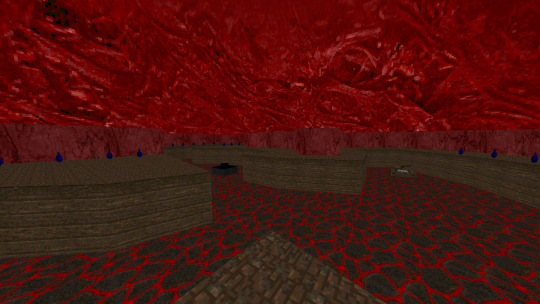
Level 25: The Temple of Darkness
Long and with multiple monster closets as well as tight and tactical combat. A nice, intense and full of adrenaline map.

Level 26: Bunker
Simple style and even has some touches of Heretic but with good combat although a bit of a puzzle/lost layout.
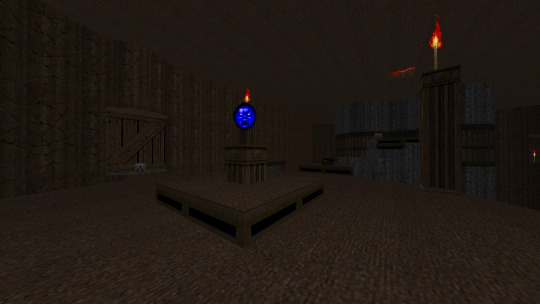
Level 27: Anti-Christ
Great, fun and hot. With a dynamic combat and varied heights, which gives good depth to the fight and makes us go through a well-balanced and entertaining challenge.

Level 28: The Sewers
Enigmatic. It leaves somewhat disturbing airs which gives it a good presentation. With a somewhat lost but well structured layout manages to create a slightly longer adventure with good action.

Level 29: Odyssey of Noises
Iconic for different reasons and controversial for others. This is an attractive map with an urban style like Sandy, combining abstract buildings with a little more attractive architecture. With an expansive and big layout, the map is quite long and a bit lost, but it compensates with a good gameplay and open combat.

Level 30: The Gateway of Hell
The end of Plutonia. A decent IoS fight with a bit of foreshadowing and good build up to the final battle, which has a few tricks up its sleeve. Overall, decent, but definitely one of the best IoS of the IWADs, if not the best.

Level 31: Cyberden
(Exit to super secret level)
Interesting gimmick map with a few Cyberdemons to keep us company.

Level 32: Go 2 It
The iconic Go 2 It. It doesn't need many words other than to say that it is a pioneer of a particular style and features a gameplay and layout as violent as it is fantastic, though unfair and cruel at times.
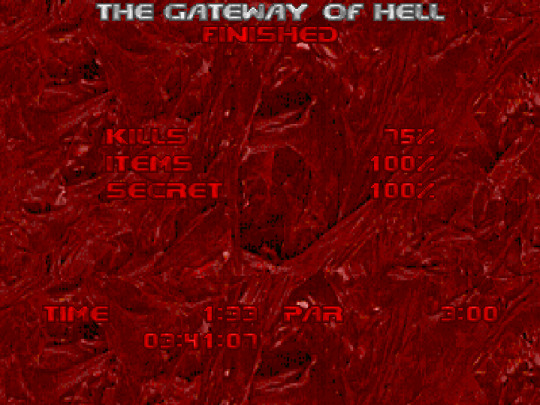
End.
» Overall:
The Plutonia Experiment (1996)
By Dario and Milo Casali
In 1996, history was made. Final Doom, the last expansion of the classic Doom, is finally released and with it brings to our eyes two of the most iconic megawads in history. The Plutonia Experiment is one of those holy or not so holy grails that we adore to this day. Considered by many as an irreplicable milestone in the history of Doom and by others as an outdated and particularly cruelly designed work. Whatever the opinion, we can all easily accept that Plutonia came to stay sedimented among the most influential megawads in history.
Made by the brothers Casali in an almost speedmapping way, almost indeed, the Plutonia Experiment, or simply Plutonia, is one of a kind, specially during the 90s when the world of WADs was still in a very primitive, almost baby-like state. Of course, things would change quite quickly but not until Final Doom hit the shelves, and oh boy did it also hit the Doom community. Of course, it is such an iconic work that it is practically as famous as the original Doom 2 or Ultimate Doom itself, bringing with its different mechanics and creative tricks that would later be replicated several times in other distinctive and fantastic ways, creating a cycle of improvements and approaches to new ideas. Plutonia is nothing new, not at all, but it's something I've barely gotten to discover properly. While I played it a long, long time ago, I could barely remember the first five levels, much less the last few. I wanted to give it one more spin, one where I could fully appreciate the creation of this magnificent specimen. I did it and now I can see with a different eye the reason for the appreciation of this megawad. The cult of the Plutonia lies deep and with a very good reason.
Visually speaking, Plutonia is twice better looking than Doom 2, and quite frankly, TNT: Evilution, and that’s something I think we can all agree upon (well, pretty much anything looks better than Doom 2 now a days.) with no major problem. Interestingly, the levels were created by only two people, which gives a certain sense of respect for the creative capacity and practical ability of the Casali brothers. Dario did a total of 14 levels while his brother Milo did a total of 18, giving their respective authors a fairly respectable number. Which level was made by whom? That we will probably never know, although speculation may tell us certain things and analysis of map techniques others, at least we can all agree that the two authors show a well-defined quality in terms of their overall quality. Almost all Plutonia maps are attractive to look at, fun to admire and have generally understandable layouts with no major visual or progressive detractors. From the first iconic level to the last IoS, each map has a distinctive shape that gives it a certain renown, with, obviously, some maps standing out more than others, such as Congo for its respective high level of difficulty for a first level, or Hunted, for its unique way of screwing up our day with a few thousand Arch-Viles (is actually just a few dozen, but let’s drop some salt in it).
Each 10 maps are divided into chapters with a specific visual theme. The first 10 are Earth Levels, with the next 10 being Hell Levels and the last 10 being Devil Hive levels, a unique mix of particularly atrocious levels with disturbing visuals. Of course, the all-mighty secret levels also have a distinctive look, but they are not particular adherent to any other chapter. The first 11 levels manage to create that earthy feel quite well by offering brown textures that seem to recreate fortresses or human settlements, as well as clearly palpable architecture and realistic definitions without needing to be hyper-realistic. They just look good for what they need to work for. From map 12 to 20 we have the infernal levels that try to recreate what seems to be hell cities, or places with red tints. In one way or another, they manage to evoke dark sensations and also offer iconic battles in rivers of blood and red skies. From level 21 to 30 we finally have the center of all corruption. The Devil Hive levels are maps that recreate inner sectors of hell, such as capitals or demonic cities. Most of them usually look good and offer long combat spaces, although some maps can be a little longer than necessary, each of them satisfies.
And when we talk about satisfaction, we, of course, have to talk about gameplay. This is probably the most brilliant point of Plutonia, and one that many would consider essential in the history of Doom WAD development. Plutonia introduced, without a doubt, the most difficult original levels of all classic Doom, making use of a totally cruel creative and planning freedom that is designed to envelop the player in levels of absolute carnage and unnecessary insanity. This resulted in a plethora of iconic levels that stand out for their absurd early difficulty, as I said earlier, Congo is probably the ideal map to represent what Plutonia is all about. I don't have to say anything else; this has already been said to death: Revenants, Chaingunners, Arch-Viles, Barons, Mancubus. Be prepared to see them in whole hordes. However, what do I think of this? Well, at first, I must admit I was a bit skeptical about my initial reaction, since I'm usually more of a fan of casual WADs that show some mercy to the players, on the other hand, I also appreciate a good shot of adrenaline to get the glands moving. Plutonia is definitely going for the latter. What we have here is the introduction of what I, and many, consider the proto-slaughtermap. Before Hell Revealed, Plutonia already had the first slaughter-style maps, such as the immortal Got 2 It. These are brutal maps, even for modern years. Sure, many other WADs have managed to surpass Plutonia's overall difficulty, including its famed unofficial sequel, but Plutonia is the starting point where it all began and from there were born distinctive WAD making moves that would later be sedimented as part of the iconic variety of this beautiful community. I can't hate that, it's simply impossible since it's a factor that, despite being so divergent, brought about a change that would end up favoring the freedom of design and the brutality of the unforgivable gameplay.
I enjoyed every second of it, from start to finish without encountering any major difficulties and that's pretty incredible, considering that all other IWADs have at least one major negative quality that tends to affect my enjoyment. Plutonia, on the other hand, didn't present me with any truly annoying factors. Even its brutal difficulty was extremely enjoyable and I'm sure it has managed to survive modern times precisely because of that.
Sure, it's a bit old, and some maps tend to be a bit more boring to look at than others, but it's a journey through time that launches us into the golden grail that everyone wanted to reach during the 90s. A time when everyone was waiting for the ''Next Plutonia''. The Casali brothers created a movement that would forever remain on the plaques of Doom history, and for that and much more, I think we should all be thankful that what we have here is, without a doubt, the best IWAD ever. Plutonia is an experience and one that everyone, without fail, should try sometime in their life. It may kick your ass, but a kick never felt so good.
2 notes
·
View notes
Text
Top 20 BEST Animated Series of the 2010s-10th Place
Aside from the first few seasons of Regular Show, there aren't that many shows for teenagers. Mostly because they're the most difficult group to appeal to. You either go too mature or not mature enough, and it really is a hard balancing act to pull off without the right amount of talent. That being said, this next show is one of the few that pulls off such a balancing act...with mild success (I'll get into that).
#10-Infinity Train (2019-)
The Plot: A mysterious train of unknown origin pops into existence to pick up passengers for one purpose: To help them grow as people. This could result in many issues, depending on the person and what troubles them the most. However, it is up to each passenger to figure out why they're on the train in the first place. And what they must do to get off and back to the real world.
Now, before you kill me for not placing this show in the top five, I want to make it clear that thirteen-year-old me would have absolutely loved Infinity Train. But twenty-one-year-old me? Let's just say that I still enjoy it, but there are issues that I have. Although, before I get into that, I should first go over what I love.
First and foremost, I love how this show is technically an anthology. I say "technically" because while each season focuses on a new character, Infinity Train builds upon other characters introduced in current or previous seasons. Some of them even being the main focus for each new story, making it a unique take on what makes something an anthology. And the fact that it's an anthology means that Infinity Train can go further with its premise. If it stuck with the same character for several seasons, the show would have to drag out that character learning the same thing over and over again or having a new issue that requires them to go back on the train. And you get the whole "not this again" bullcrap that shows up in every not great sequel ever made. But the show avoids this by introducing new characters with their own unique problems. It gives Infinity Train gets a chance to explore even more themes and story without getting stale, making it entirely possible for the show to go on for, well, infinity. This is good because Infinity Train is one of those rare shows that gets better and better each season.
Season one is...fine. I enjoy bits and pieces of it, but it's clear that the writers were trying to find footing, and target audience, for the rest of the series. Season two immediately kicks it up a notch with a more interesting character, a tightly woven story, and an incredible message that I would not have expected from season one. And by season three, everything somehow improves further due to a greater sense of drama and maturity. With most shows, the level of quality peaks at a certain point, proceeds to fluctuate in quality for a spell, and then ultimately forcing a conclusion when it's clear that nobody is watching anymore. So far, Infinity Train has yet to have peaked in quality, and I can only hope it will continue to raise the bar in the future.
But, by far, the best thing about this series is the themes and messages that it tries to teach. As stated, each season focuses on a new character, each one having their own problems and, therefore, their own lessons to learn. Even better, each moral that the season's protagonist has to learn ties brilliantly into the antagonist. Because while you have the protagonist working toward a goal to better themselves, the antagonist already accepted their fate and decides that there is no going back for them. Sometimes even convincing the protagonist to join their ideology, creating great drama and tension.
Plus, the themes of this show are perfect for teenagers. They're essential for kids to understand but a little too mature for their age. On the other end of that, while adults clearly understand each lesson, there's rarely anything that speaks directly to them. And, sorry for potential spoilers, but I got to go through each season's moral:
Season one features a moral about moving forward and not letting disillusioned memories of the past obscure the present. This message applies to family and losing a significant other, saying that no matter how "good" the past was, you still need to move forward in the here and now.
Season two is fascinating because there are two ways a person can perceive what the main message is. What I perceived was a lesson on self-existentialism, focusing on common anxiety of whether or not a person is alive and if they really exist. Other people see the main message as being about self-identity, focussing on how a person can say, "I am this" when others say, "No. You are that." Either is applicable and doesn't matter which one is the real moral. Because both are equally important and equally identifiable for almost everybody.
Then there's season three, which might just have the most well-handled message in a long time. Because season three focuses on the idea of redemption. More specifically: Whether or not a person is too far gone to be redeemed. And where most shows go the route of everybody deserving the chance of redemption, Infinity Train might just be the first series in a while to say, "Nope. There is a line drawn in the sand, and there will be consequences for if you cross it." Given the number of times I've seen a series force out redemption for a character who didn't deserve it, it is refreshing to see something that points out how there's a limit. And keep in mind, this coming from a guy who actually likes those shows despite their forced redemptions.
So with everything that this series does right, what does it do wrong? Well...first of all, this show is not as funny as it thinks it is. Sure, some moments get a chuckle out of me from time to time, but there are one too many jokes that just don't land. I'm usually a fan when a show tries to find that balance between comedy and drama, but when the comedy is pretty stale, the show comes to a grinding halt.
There are also times when it feels like an episode, or an episode's segment, that just drags on for too long. For example, the first few minutes of "The Ball Pit Car" focuses on this cutesy little segment of the characters going through a McDonald's style playpen. It was cute at first, but it quickly gets old as they follow this stuffed animal that treats the whole thing as a game.
This leads me to the main problem this show has: When it tries to appeal to kids. To me, Infinity Train's at it's best when it appeals to teens and sometimes adults. So when it introduces a quirky, cartoonish sidekick or a babyish new character, it does not work for me. There are plenty of times when appealing to all ages does a piece of media a favor (case in point: Every Pixar movie ever made), but it doesn't for this show.
However, if I was still thirteen, I would be praising Infinity Train non-stop about everything it does right, maybe even claiming it to be perfect. Now that I'm twenty-one, I still praise it, but I'm more likely to see the cracks in the armor. It has a brilliant concept, some fantastic themes, and manages to get better each season. It just needs to polish out its comedy, work on its pacing, and figure out it's intended audience. Take a ride if you have the chance. The journey may be bumpy at some points, but it is worth it for the destination.
(Also, don't be that person who pirates it. I understand if you're broke as hell and can't afford ONE streaming service, let alone the fiftieth one. But if you have the money and you can afford HBOmax, then there's no excuse for you to sign up and watch the show, especially since it's at risk of cancelling because of people pirating it.)
2 notes
·
View notes
Text
The History of the Survival Horror Genre
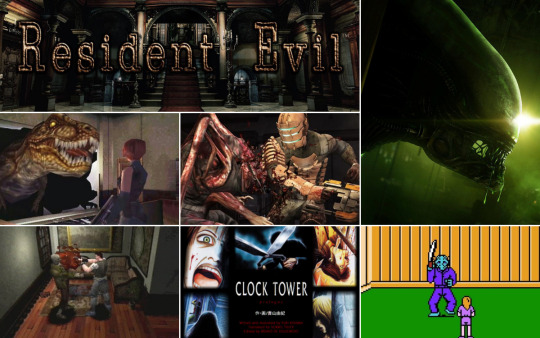
It started with a question of curiosity - “What was your introduction to the survival horror genre?”
It simply intrigues me to see where players received their first glimpse of a genre. When I put the question out onto Twitter, I never expected it to lead into a deep dive into the genre's history. However, two of the answers I received made me realize a discrepancy in the known timeline of survival horror.
Much like myself (and I’m sure many others), former game guide author Dan Birlew first experienced the genre with the sprawling Spencer mansion of Resident Evil (1996). As he explained, “Resident Evil: Director’s Cut was my first survival horror game. It’s the first time a game made tensions mount and my pulse rise while I was walking down a corridor, not sure what would pop out at me in the next camera angle. There were jump scares and also creepiness galore, and I was so impressed that a horror game was finally making me afraid... and I was immediately hooked.”
It’s exactly as I’d describe my time with the first entry in the long-running series. And it seems like such a solid starting point for survival horror. In fact, the release of Resident Evil was the first time the phrase “survival horror” was used to describe a genre of gaming. Since so many games mimicked the style and mechanics of Capcom’s zombie horror title, it only seemed logical that Resident Evil was where survival horror got its start.
But then I received two more responses. The first was from Mikael Kasurinen, director of Control (2019) and Alan Wake (2010) designer, who said:
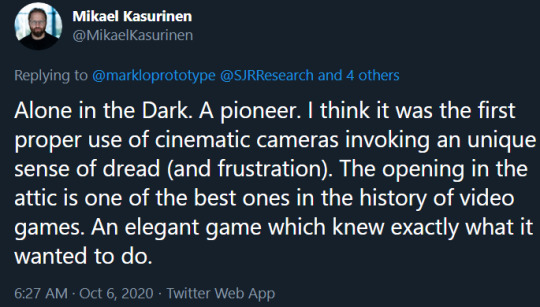
Then, indie developer Sergio Hidalgo, known best for Dreadhalls (2017) and the upcoming Cosmophobia, shared a similar response:

And that’s when it hit me.
Capcom may have coined “survival horror,” but as we’ll see in this exploration of the genre’s history, Resident Evil was merely a popular pioneer for a type of game that had already existed for more than a decade.
The 80s and the Age of Interactive Horror
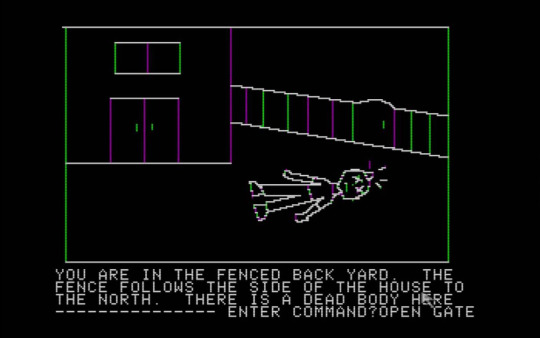
Horror entertainment has been around for centuries, with many believing English author Horace Walpole to be the medium's father with his work, The Castle of Otranto (1764). More than a century later, George Melies’ The House of the Devil (1896) brought horror into the movies. As decades passed, the genre morphed into a means of escape from the real world. The classic Universal Monsters came to be amidst the horrors of war, followed years later by the grizzly killers of the slasher genre and, later still, the advent of “torture porn.”
Nestled somewhere in that extensive timeline is Mystery House (1980), an adventure game developed by On-Line Systems (which would later become Sierra Entertainment). Today, few people would consider Mystery House scary, but the murderous events and scattered dead bodies do offer a taste of the genre. Around the same time, players were enjoying the horror-speckled murder-mystery title, another game was garnering attention - and being loosely based on an Edgar Allen Poe story, it’s hard not to see the horror influences behind the Apple II’s House of Usher (1980).

What’s so intriguing about Mystery House and House of Usher is that they weren’t marketed as horror experiences. The latter was dubbed an RPG, though it featured elements we see today in survival horror. The protagonist had a courage meter and was surrounded by mummies, hatchet-wielding killers, corpses, and other staples of the modern genre. But it didn’t fall into the horror category until many years later, and it wasn’t until 1982 that Atari released the first game to be actively marketed as a horror game - Haunted House. Sometimes considered the “original horror game,” Haunted House may not look like much, but it forced players to consider inventory management as they navigated the pitch-black home of Zachary Graves.
Atari may have introduced players to horror, but the mid- to late-80s really gave the genre steam, especially as developers shifted toward gothic horror and borrowing from other intellectual properties. Castlevania may not be scary, but its castle setting and supernatural fiends were deeply rooted in the genre. Other games like The Evil Dead (1984), Texas Chainsaw Massacre (1983), Frankenstein’s Monster (1983), Friday the 13th (1989), Halloween (1983), and Zombi (1986) showed promise of what the future held, but it was a1989 RPG that really laid the groundwork for the survival horror genre.
Home Sweet Horror
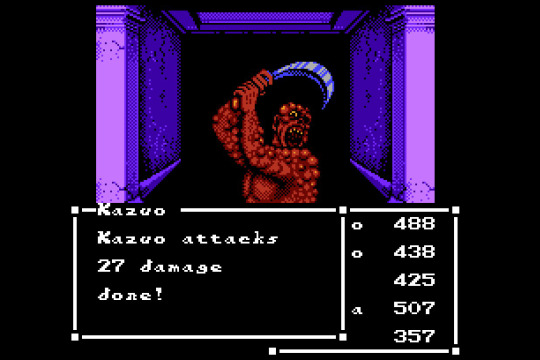
In 1989, director Kiyoshi Kurosawa released Sweet Home, a Japanese horror movie that follows a film crew as it explores the inner workings of an abandoned mansion. Sprinkle in a poltergeist and a supernatural mystery, and you have the basic premise of the movie that inspired the game that eventually gave life to Resident Evil. The horror RPG, also developed by Capcom, thrust players into a mansion riddled with supernatural terrors. Zombies, specters, and all manner of ghastly horrors threatened the sanctity of the hapless heroes throughout the sprawling manor. Sound a little familiar?
According to Sweet Home’s video game director, Tokuro Fujiwara, Resident Evil was his opportunity to do all the things he wanted to do in the original Sweet Home but couldn’t due to graphical and technical limitations. In fact, the Shinji Mikami-director survival horror title was intended to be a Sweet Home remake, but a rights issue forced Capcom’s hand. That didn’t stop the development team from borrowing elements from the 80’s RPG to flesh out the zombie romp in the Arklay Mountains.
Item management, puzzles, dreaded backtracking, character-specific items, and even the mansion setting were all siphoned from Sweet Home to build a better, more expansive horror experience. With the tech of the original PlayStation, Fujiwara would finally be able to recreate the success of Sweet Home with a visually horrifying game. But it was Mikami that spent the initial months of development sketching concepts and envisioning the final product, and it actually wasn’t Sweet Home that drove him to include one of Resident Evil’s most striking features.
Horror Gaming Gets Cinematic

In its earliest stages, Resident Evil was intended to be a first-person video game. Then Mikami happened upon Infogrames Alone in the Dark (1992), a thriller that blends the dreary tones of Edgar Allan Poe with the cosmic horrors of H. P. Lovecraft. Today, it’s known as the first 3D survival horror game, but it was just another horror adventure when it first released. Alone in the Dark had everything going for it - a creepy setting, a unique art style, solid combat, and a story that did its inspirations proud. However, it was lacking one thing it needed to shine and earn recognition as the true dawn of the survival horror genre, and that was name power.
When Infogrames released Alone in the Dark, it didn’t do so with a long history of successful releases. In fact, by 1992, the development team hadn’t really done anything even marginally stellar. Capcom, on the other hand, was knee-deep in classics. They may not have been in the realm of horror, but it was impossible to navigate the gaming industry and not come across a well-received Capcom-developed title.
Couple that with the gut reaction some players may have had toward Poe and Lovecraft's heavier works, both known for their intricate and profound themes, and you have the makings of a game that deserved the spotlight but couldn’t quite muster the same star power as Resident Evil. The 1996 title didn’t suffer the same fate and instead quickly became the best-selling PlayStation game shortly after its release.
Beyond Resident Evil
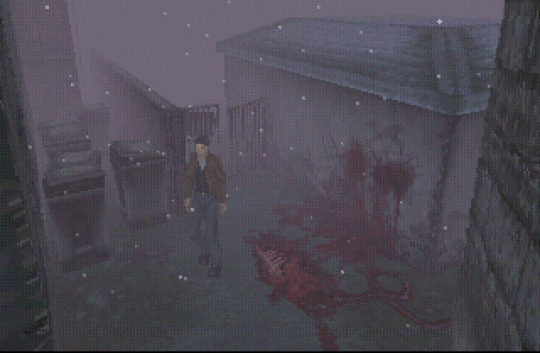
Resident Evil's commercial success indicated that there was an untapped market for survival horror video games, and so the late-90s became a treasure trove of memorable launches. In 1998, Square, already known for its Final Fantasy series, released Parasite Eve, a horror-RPG based on the 1995 Japanese novel of the same name. Though focused more on the action-RPG elements, Parasite Eve borrowed from the newly defined survival horror genre.
A year later, Konami released the first entry in a series that, like Alone in the Dark, put a heavy emphasis on atmosphere. Unlike Parasite Eve, Silent Hill made no qualms about being a horror game. From the look and feel of the foggy town to the hellish monsters that called it home, Konami took video game horror a step further than Capcom. With minimal lighting and sparce resources, players guided an “everyman” through a twisted tale backed by the jarring and haunting sounds of composer Akira Yamaoka.
The 90s continued to bring the scares with games like Dino Crisis (1999), Clock Tower (1995) and its sequel Clock Tower II (1996), Countdown Vampires (1999), Nocturne (1999), and many more. Of course, the genre didn’t just fizzle out come the new millennium. On the contrary, many of the series bred during the influx of 90s survival horror continued to thrive, paving the way for all-new franchises to take shape and expand upon the definition of “survival horror.”
Modern Horror and the Expansion of the Genre

Throughout the 21st century, Resident Evil and Silent Hill continued to dominate the horror market, but they weren’t without competition. The first few years after the turn of the century introduced players to now-forgotten gems like the trilogy of games based on The Blair Witch Project (2000), a resurgence of Alone in the Dark, and an atmospheric iteration of The Evil Dead (2000). In 2001, the Fatal Frame series entered the fray, bringing with it supernatural horrors that put Capcom’s zombies to shame.
Developers were getting smarter and started to realize that the tried-and-true formula of Resident Evil could only appease gamers for so long. Even Capcom aimed to branch out, using series like Onimusha (2001) and one-offs like Haunting Ground (2005) to expand its horror repertoire. Silicon Knights’ Eternal Darkness: Sanity’s Requiem (2002) borrowed gameplay mechanics from Resident Evil but crafted a new style of survival horror that focused on the human psyche. Manhunt (2003) from Rockstar tossed out the undead foe in favor of human terrors and grounded the genre in reality.

While Resident Evil's classic camera angle carried the genre for a spell, Capcom returned in 2005 with a groundbreaking alteration. With the angle shifted behind Leon S. Kennedy in Resident Evil 4, players could become more immersed in the horrors unfolding in front of (and behind) them. It revitalized the series and allowed the development team to integrate action elements, but also greatly influenced a project brewing in the creative minds at Electronic Arts.
Everyone had something new to add to the genre, but in 2008, body horror took center stage with Dead Space. Visceral Games transported players out into the depths of the universe to combat a resilient enemy that needed more than just a well-placed headshot to take down. Necromorphs became the scariest thing in gaming, popping out of vents and floorboards of the USG Ishimura in a game that embodied the best parts of Resident Evil, Alien (1979), The Thing (1982), and even touches of Lovecraft themes. Its faster pace proved that horror and action could reside in the same space, which became a core component of survival horror as the years went on. However, for players still pining for that feeling of helplessness often found in early survival horror, Frictional Games delivered Amnesia: The Dark Descent (2010).

Amnesia spurred a new trope of survival horror - the unarmed protagonist. It’s become a driving force for so many AAA modern horror titles, including Outlast (2013) and Alien: Isolation (2014), and is heavily prevalent in indie-developed titles. Developers continue to prove that there is still much to be done with the genre, especially as we see advancements in tech like virtual reality becoming common in the average household.
As we can see in tracing the history of survival horror, the genre is ever-evolving. Who knows what grizzly frights will be thrown our way next.
--
At SJR Research, we specialize in creating compelling narratives and provide research to give your game the kind of details that engage your players and create a resonant world they want to spend time in. If you are interested in learning more about our gaming research services, you can browse SJR Research’s service on our site at SJR Research.
4 notes
·
View notes
Photo
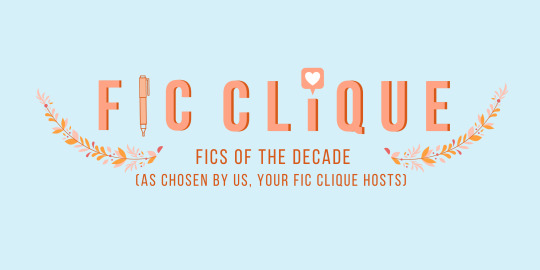
Fic Clique hosts choices for our top fics of the decade - as featured in our Minisode from Jan 3rd.
Brenna’s choices:
Honorable Mentions:
Worldwide Lonesome by loindexter (BTS)
2018, 39k, Yoongi/Jin
The biggest gut-punch I’ve ever felt from a character confession. The Jin of this fic has stuck with me every day since reading it. This fic examines sexuality in a way that made me feel seen & I love that.
Timeshare by Astolat (HP)
2016, 14k, Draco/Harry
This is sort of a stand-in for all of astolat’s drarry fic, which as a bundle are one of my top fics for the decade. They are fics that feel like instant-classics and the variety of characterizations, stories and tropes helped establish astolat as perhaps my all time favorite fic author. Timeshare won out above the others because it’s one of the fics that helped us decide to do this podcast! Thank you Timeshare!
Top 5 picks:
The Student Prince, by Fayjay (Merlin)
2010, 145k, Merlin/Arthur
A fic that has defined fanfiction for me. Perhaps the fic that first convinced me to love fanfiction. Something I keep coming back to and have reread numerous times. Funny, heartfelt, just different enough from the canon versions of characters. Perhaps the only University AU I will ever fully love.
The Love Song of the North American Douchebag, by Gyzym (Star Trek RPF)
2013, 25k, Chris/Zach
If you want to hear me (and my lovely co-hosts) discuss this fic in depth, then I recommend listening to Episode 6! However, one of our listeners also submitted this as a top fic of the decade, so I’m going to add what the lovely Scout said:
“JESUS FUCKING CHRIST, I HOPE I CAN SWEAR. I'm not even in this fandom. The world building is just THAT good. It's one of my highlights *because* of its power to draw me in as a standalone. So much fucking talent in the transformative work community. The banter, characterization, sardonic-ness of this – international impact baby!”
Not Easily Conquered (series), by dropdeaddream & whatarefears (MCU)
2015, 117k, Steve/Bucky
An incredibly, precise, gut-wrenching trilogy. Each part is astounding both together and apart. A devastating exploration of love and dedication. One of those fics that created a Fandom Moment. I sobbed through the entirety of part 2 when I first read it. Womb to tomb, sweetheart.
Azoth by zeitgeistic (HP)
2013, 88k, Draco/Harry
A stunning exploration of magic beyond JKR’s universe. A timeless coming together of two characters. A frankly genius use of a plot device (and something as simple as a school project) to foster an incredibly touching and meaningful relationship, one in which they are not able to find what they need to complete their task until they find what they need in each other. ALCHEMY BABY!
Honeysuckle Arch by junkshopdisco (1d)
2015, 46k, Niall/Harry
Perhaps the most I’ve ever related to a character in fic. The Niall of this fic lives in my heart, and I feel like reading him helps me understand myself, and everytime I come back to it I understand him better too. It’s a touching portrayal of a character coming to terms with their sexuality in a way that feels completely grounded and who is surrounded by characters who love them, even if they don’t always know how to show it.
Nicole’s choices:
Honorable Mentions:
Protostellar by ninamondays
bts, 64k, pub 2019, Namjoon/Jungkook & Taehyung/Jimin
Space, cryogenics, fate, reincarnation, class struggles, revolution, climate change, character death. Having hope is punk rock. Processing grief is a slow and ugly process. [deep breath] Have I ever felt so profoundly touched by a fic while I was reading it?
the other thing by cornfields
hockey rpf, 16k, pub 2015, Jamie/Tyler
An absolutely unflinching look at personal accountability and internalized homophobia. What happens when your self-hatred has collateral damage? It’s about healing but it’ll fucking hurt first. Bleached out vibes. Makes texas feel very big, and the world feel very, very small. A story I’d only trust a fic author to tell.
Top 5 picks:
Murmuration by fringecity (indiachick)
bts, 167k, pub 2018, Yoongi/Jimin/Taehyung
Film noir/murder mystery meets gritty sci fi and superpowers. Everyone is morally gray. You Will sob about Kim Taehyung. A masterclass in plot. Felt like a trilogy all wrapped tightly into one fic. A kaleidoscope. An unfurling. This fic mesmerizes.
The River and the Deep Green Bend by liquidmeasure
1d, 70k, pub 2016, Harry/Niall
Dark tower au, but only technically. Makes me want to believe in the multiverse. An arid western, a sideways coming of age story, an elegy. The first time I’ve ever cried because an ending was perfect.
the undiscovered country by indigostohelit
hamlet, 56k, pub 2014, Hamlet/Horatio
What else can I say about this fic. What else can I Fucking say.
(note: we discuss this fic at length during episode 5)
All Things Shining by Askance and standbyme
spn, 142k, pub 2013, Dean/Castiel & Sam/ofc
A story about miracles. Literary as hell, with long luxuriant scenes that never drag. Masterful characterization. The thing I wanted from spn fic—connection, plot, and a fic that not only can handle the lore of the show, but is willing to expand upon it.
Who Painted the Moon Black by throughthedark
1d, 95k, pub 2013, Louis/Harry
Hunger games crossover. Doesn’t just use the other fandom for setting, but entirely inhabits it. I had to stop partway through my reread because I knew I’d have nightmares, but this fic never stops hoping. Trauma is not an ending. This fic is certain of that the whole way through.
Reid’s Choices:
Honorable Mentions:
songs from the ash, by explosivesky, 2017
Critical Role, Percy/Vex, Keyleth/Vax, 54k, WIP (sort of)
rockstar/movie star AU
A fantastic example of how fic can just standalone as really good original fiction. A lovingly rendered, devastating and beautifully crafted portrait of four broken people doing their best to navigate through their lives and around one another.
delta, by sharpa, 2019
BTS, rapline ot3, 60k
What happens when you’re a public figure who gets unwillingly outed, and two people you used to love reach out to offer you sanctuary? You make Reid cry, that’s what.
Top 5 picks:
Salt on the Western Wind by Saras_Girl, 2013
Harry Potter, drarry, 60k
Immediately post war, bond
It represents a lot of what I was looking for when I started really getting into Drarry fic, which was an exploration of what canon wouldn’t give me. My favorite Drarry fics have always been the ones that let them dig into their shared trauma, and while this fic isn’t the heaviest one I’ve read, I think the fact that it’s set literally hours after the Battle of Hogwarts ends lends itself well to that concept. I couldn’t have a list of the decade without a Drarry fic, tbh.
The Great Sealand Takeover, by whalehuntingboyfriends, 2015
Roosterteeth/Achievement Hunter RPF, ot6 (gavin, michael, ray, geoff, ryan, jack), 365k
FAHC
When I think about fics that set the standard for a fandom, this is one of the first ones that comes to mind. This fic means a lot to me because it was my introduction to RPF, and in addition to its intricate plot and fandom-constructed lore, also was a take on poly relationships and found families in a way I had never experienced before, with themes of belonging and a love that transcends typical convention.
The Twice-Told Tale by arysteia, 2012
Marvel, steve/tony, 15k
This fic hits a sweet spot for me where it does have some of that 2012 tower-fic nostalgia, but I also think it holds up well in terms of what I (and fandom) find so fascinating about Tony, which is all this grief and trauma that he struggles so hard to process, and the way puts himself at the center of attention to obfuscate the fact that he keeps everyone at a long arm’s length.
There Was an Old Woman Who Lived in a Shoe, by Shoshanah-ben-hohim, 2015
Hockey, Sid/Geno, Canon Divergent, 77k
& the whole series, including There is a Field, I’ll Meet You There, Alex Galchenyuk/Olli Maata, 131k
When I think about this fic I want to scream from every rooftop I’ve ever been on “please read this fic”. The way it weaves together details to provide a level of grounding and realism in what sounds like the most absurd concept for a fic just floors me. The empathy and compassion and fear in this fic just gets at the most tender parts of my heart, and the fact that it’s ostensibly a ship fic, and yet Sid and Geno spend nearly the entire fic with no communication, but instead are just holding on to the innate truth that they know about one another to get them through this crazy endeavour they’re on elevates the entire fic for me.
what comes after, by poppyseedheart, 2018
Roosterteeth/Achievement Hunter RPF, mavinseg (gavin, meg, michael, lindsay), 36k
Dystopia/Spy AU
When I first read this fic, I finished it and I put it down and then I spent a few days feeling like I was just sort of wandering around in a haze because every single thought was consumed by this fic. In addition to its impeccable worldbuilding and the tone work that it does with its setting, I don’t know that I had ever resonated so deeply with fic characters before. Reading this felt like someone had pried my ribcage open one by one and revealed the softest, most tender parts of me and then went “I’m going to write something that targets this.” This fic is an ode to loss and love, to mourning something that you once had and then hesitantly and clumsily opening yourself up to building something new, and recognizing that, impossibly, that new thing you built can somehow be better than what you had before.
And I felt all of these things, I felt like my world had just been shattered by this new author I discovered… and then, somehow, I became her friend. Then through Nic I met Brenna, and now when I think about this fic I not only love it for being a work of art, but also for being representative of the thing that brought me to two of the most important people in my life, and that to me will always make it my favorite fic I’ve ever read.
29 notes
·
View notes
Text
Famitsu #403: Hideo Kojima interview (Metal Gear Solid)
The following is translation of an interview with Hideo Kojima that published in Weekly Famitsu #403 (September 6, 1996). A second part of this interview was published in the following issue, which would be be Famitsu #404 (September 13, 1996), which I currently don’t have access to, but I’ll post my translation if I ever get a hold of it one day.
This interview was conducted shortly after the game officially unveiled to the public in late 1996 and touches upon some ideas that did not make it into the game.
Metal Gear has a special feeling
Metal Gear is quite an old game. Why did you decide to make a sequel after all this time?
Hideo Kojima: Metal Gear came out in 1987. Has it really been ten years? The truth is that Metal Gear was actually the first game that I’ve made when I’ve joined Konami. There’s that emotional attachment, as well as a feeling of tension of “being seen or not by the enemy” that was characteristic of Metal Gear that I wanted to explore further.
For example, let’s say your character hides under a desk. When that happens, the point of view changes to under the desk and the nearby soldiers will walk around making noises. Or you hear the footsteps of a soldier, so you quickly hide inside a locker to avoid making noises. I wanted to express that kind of tension. I had the same concept with the original Metal Gear, but I wasn’t able to express it with the hardware available at the time. However, we finally have a 32-bit console capable of using many polygons, so I can finally do what I wanted to.
So you had the idea for over ten years?
Kojima: Yes, that’s right. But I started working on it a bit late since we did Policenauts first. (laughs)
It seems there are a lot of things you can do with the current 32-bit consoles that couldn’t be done with the older hardware at the time.
Kojima: At the time I wasn’t thinking of 3D, so I did the best I could under those circumstances. Since 3D is possible, on one hand you can now do this and that and anything, but in contrast everything is now harder to make. (laughs)
So will this new Metal Gear game serve as a conclusion to the previous games?
Kojima: It’s a new type of Metal Gear. To be honest, I don’t think most modern players are even aware of the original Metal Gear. So I wanted to remake Metal Gear so that people could play it again. (laughs)
Can you explain in detail what kind of game is it?
Kojima: It’s a polygon-based 3D action game. The basic idea is to infiltrate an enemy fortress where guards are roaming and you must proceed while avoiding being spotted by the enemy as much as possible and avoid all sorts of traps.
It doesn’t sound a flashy game where all you just shoot stuff.
Kojima: That’s the idea. If you get spotted by an enemy, he will called for backup with a radio or something. However, if all you do throughout the game is just hide from the enemy, then it’ll be quite a stressful experience, so there are instances where you must fight a boss-class enemy in a fancy showdown. I wanted to keep a careful balance between tension and combat.
Sounds similar to another game that became a hit recently.
Kojima: Comparisons to Resident Evil seems to be unavoidable based on its appearance. (laughs) However, I think you will experience a completely different sense of heart-pounding excitement in Metal Gear Solid. There won’t be such thing as having to readjust to the controls because the perspective has been changed. Basically your perspective remains the same throughout the game and your character will always go up when you press up on the directional pad. I wanted to realize a simple and efficient control system for players who have never played a 3D game before without making them feel out-of-place.
Menu-driven or action-based? That’s the only difference
Can you tell us a rough outline of the story?
Kojima: The hero of the game is a mercenary named Solid Snake, who also appeared in the original Metal Gear and its sequel Metal Gear 2. The setting is a nuclear weapons storage facility owned by the U.S. military located in Alaska that has been hijacked by special forces group called FOX HOUND. That’s the reason why Snake has been sent there. From his perspective, it’s a battle between himself and the members of the special forces group he used to belonged to.
So you’re saying there will be an element of human drama involved similar to the ones in Snatcher and Policenauts...
Kojima: That’s right. I’m very obsessive when it comes to making such things. In other words, Metal Gear Solid is pretty much the same as Snatcher and Policenauts, even if the method of unraveling the story is different. The themes I want players to feel is the same whether the story is unraveled by action-based gameplay or by navigating through menus. However, I think the players is able to empathize more if there is some action-based gameplay. On the other hand, action-based gameplay alone will get in the way of the story, so regulating that is difficult.
In other words, finding a balance between the action-based portions and the story you want to show is pretty important.
Kojima: Having to adjust that balance seems to be the most difficult part. I want to use movement and camera work well and show things without feeling out of place. I want to show for example, a startling movement that causes a sudden noise, naturally in one flow. While we use motion capturing, we also have a staff member who worked as an animation for almost a decade and his handmade animations is pretty nice too. You can create something nice if you know how to use these things well.
Regarding camera work, the composition will not change much and we will frequently employ cinematic techniques in which the camera moves in or away. Pre-rendered videos won’t be used much. We might used them to cut-in an image, but the actual events will be rendered in polygons. For that purpose, each character will have around 3 or 4 models.
Can you explain that?
Kojima: Suppose you’re projecting a character from a distance. If the camera moves closer to the character, the character model will become rougher as its gets close. In order to avoid this, we replace the character model with a version that has more polygons as the camera approaches the character. This is a technique often used in movies for visual effects.
You don’t want to interrupt the flow of the game as much as possible.
Kojima: The more realistic your worldview is, the more important such a thing will be. But pre-rendered videos have their merits too. You want to throw-in a video because it’s easier to express subtler effects that way.
What kind of world are you building with that much attention?
Kojima: I wanted to make a hardboiled world. And I wanted to demonstrate it as entertainment. Since we use war as a motif, there’s some heroic parts. You have your guns blazing, shooting at bad guys. You are cool, you are a hero, you’re that sort-of guy. However, if all that remains are just stuff that was cool, then I really wouldn’t call that “entertainment.” I want players to be conscious of what war means and what is a nuclear weapon by the time they’re done watching ending.



22 notes
·
View notes
Text
Sympathy for the Devilman: The Legacy of Go Nagai's Magnum Opus
I've always had a thing for villains. Unlike my brothers, as a kid I'd always choose the "bad guy" action figures. If they went for the ninja turtle Leonardo, then I'd go for the uber-buff Super Shredder. I personally identified with villainy because of how it connected to the idea of "evil." I personally see evil as a generalized concept that expresses antagonism toward violent and dominant societal structures. Due to a coercive religious upbringing, I now see how my younger self unconsciously found ideologically-oppositional comfort in "evil" art. This eventually led me to one of my most cherished pieces of fiction: Devilman.
Devilman has left an indelible mark on manga and anime creators over the last few decades, inspiring major industry heavyweights such as Hideaki Anno, Kentaro Miura, and Kazuki Nakashima. The series was created by Go Nagai, a manga auteur also responsible for Mazinger Z, Cutie Honey, and Violence Jack (which is a Devilman sequel). Although Devilman retains much of the explicitness native to Go Nagai's usual fare, it uses these graphic elements uniquely to deliver a haunting, unforgettable, and compassionate message.
Let's explore the surprisingly relevant political and social significance of Devilman, along with a few of its animated offshoots. Read on but be forewarned, this article contains major spoilers!
Devilman (original manga, 1972)
via Seven Seas Entertainment
The Devilman manga is a dark antiwar narrative in deep contrast to the standard monster-of-the-day, "evil fights evil" set-up of the anime (which ran at the same time as the manga). Ryo Asuka — who turns out to be Satan, the leader of all demons — helps convince the world that anyone dissatisfied with the status quo could turn into a demon and needs to be killed. Every nation starts a war with each other, and Japan creates the "Demon Busters" to murder anyone suspected of being a demon. This plot twist is the most explicitly political angle in Devilman and a clear critique against the genocide of marginalized peoples. One page features a taste of the global hate brewing around the world: a collective white desire to murder Black communities, the renewal of German anti-Semitism, and hatred for any protestor. There are also many moments that display the horrors of historical genocide when Akira and Ryo travel through time.
Devilman builds additional nuance around this theme with Ryo's character. In the manga's final scene, Ryo describes how demons were once oppressed by God, and that they in turn preyed upon humans in the same way that God preyed upon demons. Ryo recognizes that he continued the same cycle of genocidal hate and marginalization he once suffered. This is a striking moment that functions as a cautionary warning against abusing imbalanced power dynamics, and how even once marginalized groups are still capable of enacting horrors against those with less power.
via Seven Seas Entertainment
Ryo's character also made a groundbreaking stride in the representation of marginalized gender and sexual identities. His true form as Satan is easy to interpret as trans, possessing emotional, mental, and physical traits that defy the standard gender binary. The manga also makes it clear that Ryo considers Akira more than a friend, and is actually in love with him. Amazingly, Go Nagai does not use Ryo's trans-coded self or his queer love for Akira as fodder for insulting or disrespectful commentary from other characters. Ryo's gender-variant form is certainly mentioned, but it's never negatively framed or conflated with his murderous attitude toward humanity. Additionally, the manga never suggests Ryo is evil because of his romantic feelings for Akira (a simple, yet important distinction). It feels all the more impressive when you remember that this was made in 1972. Devilman's subversive portrayal of non-normative gender and sexual identity could still be considered groundbreaking even by today's standards.
Devilman OVAs
The first OVA, The Birth, covers Ryo and Akira's discovery of demon existence, with a very brutal early sequence that shows the bloody survival-of-the-fittest origins of life on Earth (which beautifully expands upon and mirrors the same sequence from the manga). It concludes with a gore-soaked finale where we see Akira's fateful transformation into Devilman. The sequence is filled with face stabs, top-notch body horror, and decapitations galore as Devilman rips apart demon after demon in a nightclub setting.
The second OVA, The Demon Bird, had the same crew that worked on the first OVA and contains a very similar feel. This OVA is more action-oriented than the first since it doesn't spend time on the build-up and exposition leading to Devilman's initial appearance. The animation and art design is probably even better than the first episode, which is most notable during the fight with Sirene. On a side note, the Manga Entertainment dubs for these first two OVAs are absolutely essential if you're seeking a fun evening with fellow anime nerds with a decent sense of humor. Their typically sleazy dubs — where Manga Entertainment excessively hyped up the seedier, more "adult" side of anime in order to market their products as wildly different from cartoons for kids — contain an assortment of unnecessary profanity and generally crude dialogue compared to the Japanese source material, to great comedic effect.
The third OVA, Amon: The Apocalypse of Devilman, is based on Amon: The Darkside of Devilman manga, an alternate-universe offshoot by Yu Kinutani. This OVA contains a reworked version of the end of Devilman and has a much darker edge compared to the first two OVAs. This entry in the series has an ugly, grim quality to it – such as the horrific depiction of Miki and her brother getting slaughtered by an angry mob — that initially felt off-putting to me. I started to enjoy it more on subsequent viewings however, when I remembered that, well, the entire Devilman mythos is pretty damned bleak in general. I think the desolate mood would have been more bearable had Akira felt like the compassionate, tragic hero of the manga.
Actually, overall I'd say that Akira's portrayal is one of my biggest complaints about these OVAs. He displays a cold lack of care for human life — like in the Demon Bird when he unconcernedly tears through an airplane while fighting Sirene and allows its passengers to presumably plummet to their deaths — that for me, offsets one of the biggest strengths of Devilman's core: that although Akira has the body of a demon, he never loses the tender heart of a human. With that in mind, let's explore Devilman Crybaby.
Devilman Crybaby
Devilman Crybaby is my favorite animated incarnation of Devilman, period. I might be in the minority with that opinion, but I think there's a lot to love. Masaaki Yuasa is already one of my favorite recent anime directors — Kaiba, Mind Game, and Lu Over the Wall are highlights — so it's no surprise I'd be head over heels for his take on a classic Go Nagai story.
Yuasa impressively shifts the '70s setting of the original into modern-day Japan: The group of surly highschoolers from the manga are replaced with rappers and smartphones are everywhere. In the hands of a lesser writer, a modern setting would be no more than a cosmetic, surface-level change of scenery to an already-written narrative. In contrast, Yuasa avoids this trap by using the modern setting to make incisive social commentary relevant to our times: social media is the means for both horrendous and beautiful moments in the show. It leads to Miki's murder when she posts on Instagram to defend Akira, but also serves as the online catalyst that unites Devilmen across the globe (in contrast to the original manga, where a set of demon-possessed psychic monks unite the Devilmen). Yuasa explained this in a 2018 Japan Times article:
"Today's situation is a lot closer to 'Devilman' than it was when Nagai wrote it in the '70s," he says. "The popularity of social media means people are a lot more connected, for good and bad – like someone getting shot over a video game. We learn about unarmed black people being killed by police, people being tortured and the rise of nationalism in politics. In Japan, too, where a lot of problems are openly blamed on foreigners.
"But it can also help spread good that we wouldn't otherwise know about. We see people coming out as gay or trans on social media, and there's a greater opening up and acceptance of different opinions and lifestyles."
Another beautiful aspect of the show is how Yuasa amplifies the queer elements present in the manga. Ryo and Akira's relationship feels even more loaded with romantic undertones, and Yuasa also introduces two queer characters unseen in the original manga. One of the characters is named Miki Kuroda, initially portrayed as a jealous antagonistic foil to the Miki we all know and love. Miki Kuroda changes as the episodes progress and she becomes a Devilman, and we eventually see her sacrifice herself in an attempt to save Miki Makimura, who she confesses her love to before dying. It's refreshing to see a queer woman represented in a story that previously had none, and incorporated in a way that feels organic and thoughtfully integrated within the larger narrative.
In contrast to the Akira of the OVAs, I absolutely adore this incarnation. Yuasa did a stellar job showing not only Akira's horny goth-jock side but also his compassionate traits. As the name implies, there's a lot of crying in Devilman Crybaby, and Akira is responsible for at least half the tears throughout the brief 10-episode series. Akira evokes such intense compassion and cares for people around him, which is a noticeable deviation from his cold demeanor in the OVAs. The human heart at the core of Devilman is on full display here, taking the emotional elements from the original and turning the volume up to 11. Though the art style and setting might be drastically different from what you'd typically expect of a Devilman remake, Yuasa did a masterful job honoring the source material while injecting it with fresh life and even fresher modern resonance.
What other aspects of Devilman — or its many incarnations — did you find important or interesting? Let me know in the comments below!
Do you love anime? Do you love writing? If you have an idea for a features story, pitch it to Crunchyroll Features!
6 notes
·
View notes